Polymer-Matrix Composites: Characterising the Impact of Environmental Factors on Their Lifetime
Abstract
:1. Introduction
- Part I—Environmental factors
2. Solvents
2.1. Water
2.2. Seawater
3. Liquid Chemical Agents
- Depolymerisation—extraction of the monomers from the end of the macromolecules;
- Decomposition of the monomers—cleavage of a set of atoms from the macromolecules whilst preserving the original degree of polymerisation;
- Chemical breakage of the macromolecular chains leading to a decrease in the degree of polymerisation;
4. Biotic Factors
5. UV Radiation
6. Temperature
7. Lightning Strike
- Part II—Polymer types
8. Thermoset Polymers
8.1. Epoxy
8.1.1. Water
8.1.2. Temperature
8.1.3. Hygrothermal
8.1.4. Seawater
8.1.5. Liquid Chemical Agents and UV Radiation
8.2. Vinyl Ester
8.2.1. Hygrothermal
8.2.2. Seawater
8.2.3. Liquid Chemical Agents
8.3. Polyester
8.3.1. Water
8.3.2. Seawater
9. Thermoplastic Polymers
9.1. Polypropylene
9.1.1. Water
9.1.2. Temperature
9.1.3. Hygrothermal
9.1.4. Seawater
9.1.5. UV Radiation
9.2. Polyamide
9.2.1. Water
9.2.2. Temperature
9.2.3. Hygrothermal
9.2.4. Seawater
9.2.5. UV Radiation
9.3. Polyetheretherketone
9.3.1. Water
9.3.2. Temperature
9.3.3. Hygrothermal
9.3.4. Seawater
9.3.5. UV Radiation
10. Biopolymers
10.1. Polylactic Acid
10.1.1. Water
10.1.2. Temperature
10.1.3. Seawater
10.1.4. UV Radiation
10.1.5. Microorganisms
10.2. Polyhydroxyalkanoates
10.2.1. Water
10.2.2. Temperature
10.2.3. Seawater
10.2.4. Microorganisms
10.3. Thermoplastic-Starch
10.3.1. Water
10.3.2. Seawater
10.3.3. Microorganisms
11. Conclusions
Author Contributions
Funding
Data Availability Statement
Conflicts of Interest
Abbreviations
| MDPI | Multidisciplinary Digital Publishing Institute |
| DOAJ | Directory of open access journals |
| TLA | Three-letter acronym |
| LD | Linear dichroism |
Appendix A. Summary of Existing Literature
Appendix A.1. Thermoset Polymers
| Polymer/Composite | Specimen | Tested Conditions | Time Studied | Degradation and Fatigue/Creep Effects |
|---|---|---|---|---|
| Epoxy | ||||
| Water | ||||
| Glass and glass–carbon-reinforced epoxy (30 vol%) [67] | Unidirectional laminates | Cyclic loading performed with specimens immersed in distilled water at 25 C | - | Reduction of fatigue life from 10 to 10 cycles for glass/epoxy samples. Noticeable drop-off at 45% UTS for hybrid laminates. |
| Carbon fibre-reinforced epoxy [68] | 150 × 15 mm unidirectional/ cross-ply laminates | Immersion in fresh water, seawater and seawater with 70 bar hydrostatic pressure at 50 C | 3 months | Drop-off from 80% to 65% UFS for infinite life—5 × 10 cyles—with no discernible distinction between immersion type. |
| Carbon fibre-reinforced epoxy (57 wt%) [69] | 165 × 20 × 2 mm fabric | Immersion in distilled water at 40 C | 0, 2, 8, 14, 20, 24, 72, 168, 264 and 504 h | Creep strain increased up to an immersion period of 24 h (∼0.010%) before suffering a gradual decrease to its minimum value corresponding to 504 h (∼0.0035%). |
| Temperature | ||||
| Carbon fibre-reinforced epoxy (46.96 vf%) [73] | 130 × 10 × 3 mm 3D angle-interlock woven fabric | Cyclic loading performed at 25 and 100 C | - | Reduction in tensile fatigue limit from 38% UTS at 25 C to 30% UTS at 100 C. |
| Basalt fibre-reinforced epoxy (60 vol%) [74] | 3 × 6 × 17.5 mm | Cyclic loading performed at −20, 0, 20, 40 and 60 C | - | Decrease in fatigue lifetime with increase in temperature for the same maximum fatigue stress. |
| Long carbon fibre-reinforced epoxy (60 vol%) [75] | 1 mm thick unidirectional/ cross-ply laminates | Cyclic loading performed at 20 and −196 C via immersion in liquid nitrogen | - | Tensile and fatigue strengths augmented by a factor greater than 1.5 with a decrease in temperature. |
| Hygrothermal | ||||
| Glass fibre-reinforced epoxy [79] | ISO 14130: 0 unidirectional samples | ASTM D5229/D5229M: T = 50 C (immersion in demineralised water) | 500, 1000, 1500 and 4800 h according to | Fatigue lives of conditioned specimens shortened by three orders of magnitude. Permanent 17% mechanical performance reduction after drying due to degradation. |
| Glass fibre-reinforced epoxy (55 wt%) [81] | ASTM D3479: 3 mm thick laminates | Conditioning at 40 C and 60% RH | 180 days | Fatigue life reduction from 10 cycles to 5.8 × 10 cycles. |
| Glass fibre-reinforced epoxy (55 vol%) [82] | 100 × 10 × 2.8 mm unidirectional coupons | 60% RH at 50 and 70 C. Immersion in distilled water at 60 and 90 C. | 160, 180, 77 and 11 days | Significant deterioration in fatigue behaviour due to leaching of the glass fibres and hydrolysis of the epoxy resin. |
| Flax fibre-reinforced epoxy (37.7 vol%) [83] | 4 mm thick 250 × 25 mm and 80 × 25 mm coupons | 50% RH at 23 C. Some samples were then immersed in distilled water at 70 C. | Up to mass equilibrium/26 days | For 20,000 cycles, maximum stress reduced from 196 to 148 MPa. Slope of the corresponding fitting curve superior for aged samples—enhanced fatigue resistance for high numbers of cycles. |
| Flax fibre-reinforced epoxy (40 vol%) [85] | ASTM D3479: non-woven coupons | Immersion in a water bath at 45 C. Cyclic loading performed at 23, 50 and 75 C. | Until saturation. | At ambient temperature and 50% loading level, fatigue modulus loss increased to 70% from 25–30%. |
| Seawater | ||||
| Basalt fibre-reinforced epoxy [87] | 70 mm long and 3 mm wide with a 20 mm gauge length | ASTM D1141-98: immersion in artificial seawater via a salt solution | 1, 3 and 6 weeks | Maximum applied stress reduced by 11% for 10 cycles following conditioning for 6 weeks. |
| Carbon fibre-reinforced epoxy (40 vol%) [88] | Notched laminates | ASTM D1141: immersion in artificial and natural seawater | 30 and 60 days | For 10 cycles, stress amplitude 1.2 times higher for dry laminates. No discernible differences for high-cycle fatigue. |
| Liquid chemical agents | ||||
| Carbon fibre-reinforced epoxy [89] | ASTM D3039: unidirectional pultruded plates according to | ACI 3R-04: immersion in distilled water and an alkaline solution with a pH = 12.6 | 2 years | Fatigue lifetime reductions of 69.28 to 60.75% UTS, 73.39 to 68.55% UTS and 65.00 to 54.41% UTS for, respectively, S-N curve fitting, Whitney’s and Sendeckyj’s methods. |
| Glass fibre-reinforced epoxy (56 wt%) [90] | 2.2 mm thick plates | Immersion in acidic and alkaline solutions with a concentration of 5, 15 and 25 wt% | 1, 2, 3 and 4 months | Fatigue strength and life reductions of 21.36 and 62.38% for specimens conditioned in the 25 wt% alkaline solution for 4 months. Fatigue strength and life reductions of 41.95 and 97.19% for specimens conditioned in the 25 wt% acidic solution for 4 months. |
| Radiation | ||||
| Carbon fibre-reinforced epoxy [92] | ASTM D638-03: tri-axial laminates according to | UVB radiation in an unloaded condition with an intensity of 313 | 750 h | For stress ranges smaller than 500 MPa, reduction in fatigue lives from above 10 cycles to below 10 cycles. |
| Glass fibre-reinforced epoxy (50 wt%) [93] | - | -ray irradiation at doses of 20, 100 and 200 kGy at room temperature | - | Severe reductions in both maximum stress and number of cycles with increasing irradiation dose for low-cycle fatigue (N ≤ 10). |
| Vinyl ester | ||||
| Water | ||||
| Glass fibre-reinforced vinyl ester [94] | Uni- and bidirectional laminates | Immersion in distilled water at 40 C | 30 to 600 days | Reduction in fatigue lives more pronounced with higher exposure times and stress levels. |
| Seawater | ||||
| Glass fibre-reinforced vinyl ester (66 vol%) [95] | ASTM D2290: double notched 23 mm wide rings | ASTM B-117: T = 35 C (exposure to salt water spray); immersion in oxygenated salt water and 100% RU conditions | 300 to 10,000 h | Reduction in stress amplitude from 24 to 15 MPa for 10 cycles after salt water spray exposure for 300 h. Reduction by a factor of 6 in lifetimes after immersion in oxygenated salt water for 10,000 h. Fatigue strength and life reduced by ∼2 MPa and a factor of 2 after exposure to 100% RU for 10,000 h. |
| Glass fibre-reinforced vinyl ester (28–30 vol%) [96] | Pultruded unidirectional coupons | Exposure to a 3.5 wt% salt solution at 65 C and fresh tap water at 45 C | - | Significant decreases in fatigue strength for long-term conditioning. No discernible differences for short-term exposure. |
| Glass fibre-reinforced vinyl ester (34 vol%) [97] | ASTM D790-92 bars | Exposure to water and salt solutions (5 and 10 wt% NaCl) | up to 6570 h | At 30% UFS, fatigue lives were recorded to be reduced from beyond 10 cycles to within 10–10. |
| Carbon fibre-reinforced vinyl ester [98] | ASTM D7264: woven fabric | ASTM D1141: immersion in synthetic seawater | 140 days | Decrease of ∼62% across all strain ranges. Superior impact for low-cycle fatigue: average measured reduction between 37% at 0.46% strain range to 90% at 0.6% strain range. |
| Carbon fibre-reinforced vinyl ester [99] | Carbon stitched bonded fabric | Cyclic loading performed with specimens immersed in seawater. Immersion in seawater at 40 C. | 6 months | 71% degradation in the number of cycles to failure for laminates tested immersed in seawater. Drop of 30% for preconditioned samples. |
| Liquid chemical agents | ||||
| Basalt fibre-reinforced vinyl ester (70 vol%) [100] | Tendons with = 4 mm | Spraying with artificial acid rain—pH = 2.5—during cyclic loading | - | 58% decrease in the slope of the S-N curves. |
| Polyester | ||||
| Water | ||||
| Glass fibre-reinforced vinyl ester (55 vol%) [101] | 300 × 25 × 3.5 mm laminates | Immersion in water | 1 month | Fatigue life reduction to one-ninth compared to the dry samples for a stress level of 40% UTS following a moisture uptake of 0.38% with respect to the initial weight. |
| Seawater | ||||
| Short randomly oriented glass fibre-reinforced vinyl ester (30 vol%) [102] | ASTM D790 specimens | Immersion in natural seawater | 90, 180 and 270 days | Reductions in fatigue performance. Drop exacerbated with increasing immersion times. |
| Glass fibre-reinforced vinyl ester (55 vol%) [103] | 5 and 10 mm thick non-crimp panels | Immersion in a 3.5 wt% NaOH solution prior to tensile fatigue test in the same conditions. | 30 days | Significant reduction in fatigue lives under a simulated marine environment. No changes in slope of the S-N curves: same failure mechanisms. |
Appendix A.2. Thermoplastic Polymers
| Polymer/Composite | Specimen | Tested Conditions | Time Studied | Degradation and Fatigue/Creep Effects |
|---|---|---|---|---|
| PP | ||||
| Water | ||||
| Recycled PP reinforced with short glass fibres (5 wt%, 10 wt%, 20 wt%, and 30 wt%) [109] | ASTM type I tensile bars, 4 mm thick | ASTM D5229: immersion in distilled water at 25 C | 120 days | Reduction of fatigue life. Rate of degradation in fatigue reinforced with 5 wt% glass fibre is approximately the same for both wet and dry conditions. For 10, 20, and 30 wt%, drastic decrease in fatigue strength over longer number of cycles originated from interfacial degradation |
| Sisal fibre-reinforced PP [118] | 120 × 12.5 × 2.5 | Water at 28 C | 3 days | Reduction of tensile strength due to plasticisation. |
| Flax fibre-reinforced PP (both Green and Duralin fibres) [253] | Fibre mat | DIN 53495: immersion in water at room temperature | 60 days | Up to 40% reduction is stiffness for Green flax/PP for an immersion time of 8 days. Negligible effects on tensile strength |
| Short hemp–glass fibre hybrid PP composite [113] | – | ASTM D570-98: immersion in distilled water at 40, 60 and 80 C | Up to 3624 h | Reduction in strength and stiffness, 40% and 47% respectively, mainly due to interfacial degradation |
| Sisal fibre-reinforced PP (10 wt%, 20 wt%, and 30 wt%) [254] | ASTM type I tensile bars | Immersion in hot water at 90 C | 216 h | Reduction of both stiffness and strength with increasing water immersion time and fibre content, firstly due to plasticisation effect then from the leaching out of fibre materials. |
| Temperature | ||||
| Wood fibre-reinforced PP (40 wt%, 50%, and 60 wt%) [110] | – | Insulated chamber at 23, 40 and 60 C | 2 h | Creep modulus is verified to decrease with an increase in temperature. At 60°, after 180 min, close to 65% lower relatively to the one for the same conditions at room temperature. |
| E-glass fabric-reinforced PP (60 wt%) [111] | 50 × 5.75 × 2 | Temperature chamber at 20, 50 and 100 C | – | Decrease in both tensile strength and fatigue limit with increase in temperature. For 100°, nearly 18% and 17%, respectively, relative to room temperature |
| Wood flour-reinforced PP (46 wt%) [255] | Type III ASTM D638 (14 mm thick) | −10, 21, 30, 45 and 65 C | 48 h | Drastic reduction of both elasticity modulus and ultimate strength with increase in temperature, mainly due to the surpassing of . |
| Seawater | ||||
| Glass fibre-reinforced PP [116] | 150 × 30 × 0.3 mm | ASTM D5229: both distilled and simulated saline environment at 25 and 60 C | Up to 6 months | In saline environment, nearly full loss of tensile strength and reduction of almost 85% of transverse tensile strength. Effect attributed to poor interface strength and corrosion of glass fibres. |
| Wood flour-reinforced PP (50 wt% and 70 wt%) [117] | – | ASTM: D-7031-04: distilled, Caspian Sea and Persian Gulf water | Up to 30 days | 26% higher reduction of flexural strength under saline environment compared to distilled water |
| Coir fibre-reinforced PP (5 wt%, 10 wt%, 15 wt% and 20 wt%) [256] | – | Saline water | Up to 6 weeks | Increase in weight loss with fibre content. Maximum registered loss of 8% for 20 wt% coir fibre content |
| UV radiation | ||||
| Sisal fibre-reinforced PP [118] | 120 × 12.5 × 2.5 | UV radiation in a weatherometer | Up to 12 weeks | Loss of tensile strength hindered by increasing fibre content. Reduction of nearly 95% of tensile strength for unreinforced PP, mainly due to chain scissioning and photooxidation |
| Flax fibre-reinforced PP (30 wt%) [119] | – | UV irradiation at a wavelength of 340 nm and 1.55 | Up to 960 h | Reduction of both bending modulus and flexural strength (17.03% and 26.43%, respectively). Damage attributed to the number and size of surface cracks |
| Pine fibre-reinforced PP (30 wt%) [119] | – | UV irradiation at a wavelength of 340 nm and 1.55 | Up to 960 h | Reduction of both bending modulus and flexural strength (9.72% and 9.70%, respectively). Damage attributed to the number and size of surface cracks |
| PA | ||||
| Water | ||||
| Short glass fibre-reinforced PA6,6 [124] | – | 45% and 93% RH both at 25 C | Until saturation | S-N curve of dry samples is above than for the wet. There is also a low difference in the endurance limit (40 MPa for dry and 35 MPa for wet) |
| Short glass fibre-reinforced PA6,6 [125] | ASTM D638 Dumbbell | Immersion in boiling water | At least 24 h | Reduction of tensile strength and elastic modulus. Increase on fracture strain. Effects explained by plasticisation. |
| Impact modified short glass fibre-reinforced PA6 (35 wt%) [126] | Dumbbell (3.8 mm thick) | Immersion in water at room temperature | Up to 140 days | Exponential decrease in tensile properties increasing water content. Reduction of approximately 14% of fatigue strength. |
| Short E–glass fibre-reinforced PA6,6 (10 wt%, 20 wt% and 30 wt%) [127] | ASTM D638 Dumbbell | Immersion in distilled water | 60 days | Reduction of tensile strength and elastic modulus (nearly 50% and 80%, respectively). |
| Short carbon fibre-reinforced PA6 [131] | Dumbbell (GB/T 1040:2-2006) | ASTM D5229: immersion in water at 20, 40 and 60 C | Up to 2 months | Loss of tensile strength and elastic modulus increasing ageing temperature and moisture content. |
| Carbon fibre-reinforced PA 6 (35 wt%) [132] | 250 × 10 × 1 | ASTM D5229: immersion in water | Until saturation | Drastic reduction of mechanical properties due to plasticisation effects. Loss up to 62% of tensile strength and 83% of elastic modulus. |
| Temperature | ||||
| Short glass fibre-reinforced PA6,6 [124] | – | 23 and 130 C at 50% RH | During test | Reduction of elastic modulus and ultimate tensile strength (63% and 60%, respectively). |
| Short carbon fibre-reinforced PA6 [128] | Dumbbell (3 mm thick) | 23, 50, 70 and 90 C | During test | Reduction of both tensile and compressive strengths as well as elastic modulus with increase in temperature. Consequent reduction in fatigue life. |
| Short glass fibre-reinforced PA6,6 (35 wt%) [129] | Dumbbell (1 and 3 mm thick) | 23 and 130 C | During test | Reduction of fatigue limit (47% for T = 1 mm and 57% for T = 3 mm) |
| Seawater | ||||
| Short glass fibre-reinforced PA6 (50 wt%) [133] | ISO 527-2 type 1A | Immersion in both distilled and saline (5 g/L NaCl aq.) water at 90 C | 100 h | No significant influence due to the salinity |
| UV radiation | ||||
| Glass fibre-reinforced PA (10 wt%) [134] | – | UV irradiance at 550 | Up to 1000 h | Reduction of tensile strength (13%) up to 750 h followed by a restitution at 1000 h of exposure attributed to probable matrix cross-linking. Reduction of flexural strength. Development of cracks and disbonding. |
| Both unreinforced and carbon fibre-reinforced PA6 (25 wt%) [135] | Dumbbell | UV-C irradiation at 254 nm and 20.2 | Up to 7 days | Significant decrease in tensile strength for unreinforced PA. No clear effect on the reinforced specimens. |
| Carbon fibre-reinforced PA6 [136] | 10 × 80 × 4 | UV irradiation at 200–400 nm | Up to 600 h | Slight increase in degree of crystallinity. No noticeable effect on mechanical properties |
| PEEK | ||||
| Water | ||||
| Carbon fibre-reinforced PEEK (54 vf%) [138] | 3 mm thick | 65% RH at 23 C and immersion in boiling water | Until saturation | Tensile fatigue practically unaffected |
| Carbon fibre-reinforced PEEK (60 vf%) [139] | – | Immersion in distilled water at 23, 70 and 100 C | Until saturation | No effect whatsoever on mechanical properties. Explained by the low moisture uptake |
| Carbon fibre-reinforced PEEK [145] | ASTM D790 specimens (0.125 mm thick) | 60, 70 and 80 C at 80% RH and immersion in distilled water at 70 and 80 C | Up to 118 days | Slight reduction (15% of flexural strength). Tensile strength barely affected. |
| Carbon fibre-reinforced PEEK (63 wt%) [146] | ASTM D3039 and D790-81 specimens (1.2 mm thick) | 60, 75, 80 and 95 C at 75% RH, 80 C at 85% RH and immersion in water at 80 C | Up to 1400 h | Reduction of 15% and 17% of tensile strength and 17% and 19% of flexural strength for exposure at 80% RH and immersion in water, both at 80 C, respectively. |
| Carbon fibre-reinforced PEEK (60 vf%) [147] | 30 × 12 × 1 | Immersion in boiling water | Up to 168 h | Unphased longitudinal tensile strength. Reduction of transverse tensile strength due to interfacial weakening deriving from water uptake in the interphase. |
| Temperature | ||||
| Carbon fibre-reinforced PEEK (61 vf%) [128] | 100 × 10 × 2 | 100 C | 1 h of reconditioning and during test | Negligible effect on fatigue strength |
| Carbon fibre-reinforced PEEK (61 vf%) [140] | ASTM D3039-93 (240 × 25.4 × 2.0 ) | RT, 75, 100, 125 and 150 C | During test | Nearly 80% retention of stiffness and tensile strength. Drastic reduction at 150 C due to the proximity to and consequent softening of the matrix. Reduction of the fatigue performance with increase in temperature (approximately 20% loss of strength relatively to room temperature determined S-N curve. |
| PEEK [142] | Dumbbell (5.4 mm thick) | Temperatures between 20 and 200 C | During creep test (1 h) | Slight decrease in stiffness from 20 to 140 C. Strong creep behaviour above 130 C due to the proximity to . After 1 h, creep compliance at 200 C was nearly 9 times larger than at 20 C. |
| Both unreinforced and carbon fibre-reinforced PEEK (60 vf%) [144] | 150 × 10 × 1 | 23, 80, 120 and 140 C for reinforced and 23, 60, 80 and 100 C for unreinforced | During creep test (10 h) | Greater creep compliance with increase in temperature. Significant increase in compliance at 140 C |
| Seawater | ||||
| Victrex™ and Tronic Ltd™ PEEK [148] | 35 × 12 × 3.2 and = 20 × 1 | Distilled water and sodium chloride solution with a salinity of 35‰ at 30 and 75 C | Until saturation | No significant difference in both absorption and diffusion |
| Braided Carbon fibre-reinforced PEEK [149] | 103 × 15 3.18–3.32 mm thick | Immersion in water and saline solution (0.9% NaCl) at 40 C | Up to 12 weeks | No effect on the specimens’ mechanical properties for both water and saline immersion conditions |
| UV radiation | ||||
| PEEK sheets [150] | Dumbbell (0.4 mm thick) | UV irradiation at a wavelength of 250–400 nm and 3.47 | – | Embrittlement of the specimens (increased yield strength and drastic reduction of elongation at break |
| Carbon fibre-reinforced PEEK (60 vf%) [151] | 2.5 mm thick | ASTM G 154: alternating between UV wet-cycle conditions of 8 h of UV irradiation at 60 C and 4 h of dark condensation at 50 C | Up to 900 h | Slight decrease in the elastic modulus on samples with higher crystallinity degree due to photo-degradation |
| Carbon fibre-reinforced PEEK (30 vf%) [152] | Dumbbell (4 mm thick) | ASTM G 154: alternating between UV wet-cycle conditions of 8 h of UV irradiation of 1.55 at 70 C and 4 h of dark condensation at 50 C | Up to 1560 h | Reduction of the elastic modulus (7.5%) after 1560 h of exposure. No documented effect on tensile strength. Superficial fibre/matrix debonding was observed. |
Appendix A.3. Biopolymers
| Polymer/Composite | Specimen | Tested Conditions | Time Studied | Degradation and Fatigue/Creep Effects |
|---|---|---|---|---|
| PLA | ||||
| Water | ||||
| Rigid PLA [25] | – | Simulated aquatic medium under constant light at 30 C | 112 days | Negligible weight loss |
| Blends of PLLAs and 20 wt.% of PCL [178] | mm × 30 mm | Phosphate solution (pH = 7.4, 37 C) | 1, 2, 3, 6, 12, 18 and 24 weeks | Blends containing PLLAa degraded slower than blends of PLLAb. <10% of the initial molar masses and shear strengths of the blends left after 12 weeks in vitro. |
| 72% PLA, 28% talc [180] | Food utensils | Composting 65 C (aerated once/twice per week) | 7 weeks | 34% mass loss due to hydrolysis. Reduced to small fragments. |
| PLA grades [181] | 150 m thick films | Bidistilled water (58 C, pH = 5.7) | up to 68 days | Mass loss from 70% after 30 days to 54% in 68 days. pH of medium increases initially and then decreases. |
| Starch (0–70%), PLA (13–100%) PHEE (0–27%) [182] | 16.51 × 1.91 × 0.318 cm | Soil water content: 15–25%; Soil temperature: 0–30 C | 1 year | Pure PLA: no detectable weight loss; little decline in strength. Weight loss increased with increasing starch and PHEE contents. |
| PLA [184] | – | Composting at 50–60 C | 45–60 days | Broken down into smaller molecules |
| PLA [185] | 1.2 × 1.2 cm × 320 m | Freshwater (T = 25 C and under fluorescent light, 16 h light and 8 h dark) | 1 year | No degradation reported |
| PLA/TiO nanocomposites [187] | 1 × 2 cm | Phosphate-buffered solution (pH = 7.4 at 37 C) | 70 weeks | weight losses up to 8.6% for TiO2-15 after 70 weeks |
| PEG-PLA hydrogels [188] | mm × 5 mm | Testing frequency of 3 Hz | 10 days | Total mass loss in 8 and 10 days depending on cross-linking density |
| Buriti–fibre/PLA composites [202] | 200 × 100 × 1 mm | Simulated marine environment (22–25 C, pH = 7.9–8.5) and several organisms | >600 days | 10–12% weight loss |
| PLA/hydroxyapatite composite [209] | Rods ( mm) | Phosphate-buffered solution (pH = 7.4 at 37 C) | 50 weeks | Strength above 200 MPa up to 24 weeks |
| Temperature | ||||
| PLA [191] | 7 × 3 × 0.02 cm and 2 × 2 × 0.02 cm | T = 25, 37, 45, 50, 55 C in soil and compost | 1 year | At 55 C, tensile strength lost after 9–12 days. At 37 C, 53% of tensile strength lost after a year. |
| PLA/talc blend [193] | 2 cm | 35 C (2 days) followed by 58 C (20 days) | 22 days | No mass loss; yet showing visible signs of degradation |
| PLA films [196] | Thickness 20–400 m | Buried in Mediterranean soil conditions. In addition, lab and composting tests. | 11 months | Higher temperatures (about 60 C) required for total degradation. Almost no degradation at 30 C after 20 days. |
| PLA films [197] | – | Costa Rican soil (average temperature of 27 C and moisture content of 80%) | 12 weeks | 42% weight loss after 12 weeks. Estimated 6 months for total degradation |
| PLA with starch/ wood–flour [198] | 10 × 20 × 3 mm | AS ISO 14855 | 80 days | Degradation increases from about 60% to 80% when the starch content increases from 10% to 40% |
| PLA-grafted acrylic acid/starch films [199] | 50 × 35 × 0.05–0.02 mm | Saline solution (0.85% NaCl, pH = 7.0, T = 37 C) | 180 days | >77% weight loss |
| PLA/kenaf bast fibre [200] | – | Compost soil burial | 6 months | No degradation for PLA. 13% decrease in weight retention after 11 weeks for PLA/50 wt% kenaf fibres |
| PLA films [216] | 0.3 mm thickness | Composting conditions (temperature up to 59 C) | 70 days | Disintegration of the samples and formation of acidic water-soluble degradation products |
| Seawater | ||||
| PLA [185] | 1.2 × 1.2 cm × 320 m | Artificial seawater (T = 25 C and under fluorescent light, 16 h light and 8 h dark) | 1 year | No degradation |
| PLA/corn starch biocomposites [195] | 40 × 10 × 0.4 mm | Soil burial (T = 30 C, 80% relative humidity and composting microorganisms) | 6 weeks | No weight loss |
| PLA splines [201] | 80 × 4 × 2 mm | Natural seawater (Coastal Bohai Bay, China) | 1 year | 2% weight loss |
| PLA/buriti fibre [202] | 200 × 100 × 1 mm | Simulated marine environment (T = 22–25 C, pH = 7.9–8.5, simulated UV radiation and several organisms) | 600 days | 10–12% of weight loss |
| PLA films [203] | 30 × 3 × 0.05 mm | Natural conditions (Pacific coast off Japan, T = 19–26 C) | 5 weeks | 25% weight loss. Complete loss of mechanical strength. |
| PLA films [204] | 30 × 3 × 0.05 mm | Natural conditions (static oceanic seawater from Aichi, Japan, T = 25 C) | 10 weeks | No weight loss. No change in mechanical properties. |
| PLA splines [205] | 180 × 10 × 4 mm | Lorient harbour (France), T = 11–19 C | 6 months | No mass low. Only slight tensile strength loss reported. |
| PLA/flax biocomposites [206] | Dog-bone geometry | Natural seawater (Brest Estuary). T = 20 and 40 C | 3 months | Molecular weight loss between 44–58%, higher for film stacked composites. 10% decrease in Young’s modulus; ∼30% decrease in strength. |
| UV radiation | ||||
| PLA-PHBHHx blend films [177] | 3 × 1 cm × 125 m | Vacuum oven at room temperature (24 h) and annealed at 60 C (30 min) | 3 h | Loss of toughness; “rapid” physical ageing. |
| PLA/3 wt% carbon black films [210] | 8 × 10 mm thick | Avg. solar irradiance: 27 mW/cm | 14, 30, 60, 90 and 240 days | Elongation at break and tensile stress increased after 60 days and, after 240 days, the maximum elongation at break was 25% of its original value. Decrease in molar mass of 15% after 90 days. Increase in E after 90 days of exposure. |
| Microorganisms | ||||
| PLA [158] | – | ASTM D.5526-94 (2002): T = 21 C, RH = 49%, 55%, 65% | 390 days | Little biodegradation |
| PLA [158] | – | Adapted from ISO 15985 and ASTM D.5511-02: T = 35 C | 170 days | 36% degradation |
| PLA utensils [180] | – | Composting environment, T = 65 C | 7 weeks | Mass loss of 34% |
| PLA films [192] | – | Cultures of Amycolatopsis sp. deposited onto PLA films | 14 days | 60% mass loss |
| PLA/corn starch [195] | 10 × 20 × 0.4 mm | Proteinase K solution (50 mM Tris-HCl buffer, pH = 8.6, T = 37 C) | 10 days | Complete disintegration in <10 days. The higher the starch content, the faster the degradation. |
| PLA/chitosan composites [212] | 3 × 3 cm | Adapted from SR EN ISO 846/2000: sterile (pH = 6.6) and natural (pH = 7.0) soils | 150 days | <3% mass loss. <84% increase in Young’s modulus and <35% decrease in tensile strength, depending on % chitosan. |
| PLA99.0 and PLA77.0 [213] | Plate 5 × 9 cm | Soil burial, pH = 6.8 | 17–20 months | Higher molecular weight decrease after 20 months than after 17 months. Negligible weight loss. |
| PLA trays [214] | – | EN13432 at ambient temperature: Composting 15–30 C | 180 days | No mass loss |
| PLA with additives [215] | 2 × 2 cm | ASTM 5338: T = 45–70 C | 17 days | 97% reduction in molar mass |
| PLA, PLA/PHB blend [216] | 40 × 3 × 0.3 mm | Industrial composting, T = 52–59 C | up to 70 days | No mass loss, with changes in average molar mass after 21 days. Complete disintegration after 70 days. |
| PLA/cellulose fibre composites [217] | – | T = 30 C, RH 60% | 600 h | Losses up to 40% in tensile strength |
| PLA powder [218] | Particle sizes: 125–250 m | T = 37 C | 277 days | 43% of biodegradability |
| PLA powder [219] | Particle sizes: 125–250 m | Modified ISO 13975: T = 55 C | 75 days | 75% of biodegradability |
| PLA/cellulose nanocomposites [220] | 15 × 15 × 0.03 mm | ISO 20200: enzymatic-active medium, T = 37 C | 21 days | Higher degradation for PLA (up to 3 days) with respect to PLA nanocomposites (up to 10% remaining after 21 days). |
| PHA | ||||
| Water | ||||
| PHB [185] | 1.2 × 1.2 cm × 320 m | Freshwater (T = 25 C and under fluorescent light, 16 h light and 8 h dark) | 1 year | Approx. 8.5% mass loss |
| PHB discs [222] | mm × 0.08–0.1 mm | Freshwater (T = 5.5 C, depth of 4 m) | 35 days | 21% weight loss. Half-life of 55 days. |
| P(3HB) samples [223] | Dog-bone geometry (2-mm thick) | Freshwater (T = 5–20 C, pH = 5.4–6.6, depth of 0.5 m) | 358 days | 34–100% mass loss depending on the formulation |
| Temperature | ||||
| PHB [224] | Dog-bone; 2 mm thick | T = 40 C; water content: 14–22%; pH = 6.3–7.1 | 150 days | 60% weight loss of 0.64% per day |
| PHB films [257] | 8 × 8 mm × 108 m | Soil burial as per ASTM D 5988; temperatures up to 30 C | 50 days | 50% weight loss |
| Seawater | ||||
| PHB [185] | 1.2 × 1.2 cm × 320 m | Artificial seawater (T = 25 C and under fluorescent light, 16 h light and 8 h dark) | 1 year | Approx. 8.5% mass loss (same for pure water) |
| PHB splines [203] | 30 × 3 × 0.05 mm | Natural conditions (Pacific coast off Japan, T = 19–26 C) | 5 weeks | 65% weight loss. Complete loss of mechanical strength. |
| PHB films [204] | 30 × 3 × 0.05 mm | Natural conditions (static oceanic water from Aichi, Japan, T = 25 C) | 10 weeks | 9% weight loss. 40% decrease in mechanical strength. |
| P(3HB) samples [223] | Dog-bone geometry (2-mm thick) | Seawater (Zeebrugge harbour, T = 6–14 C, pH = 7.6–7.9, depth of 6 m) | 270 days | 31–52% mass loss depending on the formulation |
| 3-PHB disks [225] | mm × 0.1 mm | Tropical marine environments (T = 28.8 C, pH = 7.0–7.5) | 160 days | 58% residual weight |
| PHB–38–wt% TiO composite [232] | 10 × 10 mm | River estuary (T = 32.0 C, pH = 7.06) | 8 weeks | Up to ∼82% mass loss depending on the region |
| PHB films [258] | 12 × 12 × 0.32 mm | Natural conditions (Osaka port, T = 14.3–19.2 C; Misaki town, T = 12.5–14.0 C, Japan) | 6 weeks | 40–100% weight loss |
| PHB films [259] | 0.005–0.1 mm thick | Natural conditions (South China Sea, T = ∼28 C, pH = ∼7.2) | 160 days | 38–58% weight loss depending on the thickness of the film |
| PHB films [260] | 0.1 mm thick | Simulated conditions (Tokyo bay and Pacific Ocean, T = 25 C) | 28 days | Weight loss: 23%—oceanic waters; 41%—bay waters |
| PHB films [261] | 0.15–0.19 mm thick | ASTM 6691: artificial conditions (13 marine microorganisms, T = 30 C) | 49 days | 30% weight loss. 14% weight loss for flowing water testing. |
| R-PHB films [204] | 3 × 30 mm × 50 m; 18 × 30 mm × 25 m | Dynamic seawater (T = 19–26 C, depth of 1.0 m) | 35 days | 60% weight loss |
| UV radiation | ||||
| PHB [231] | 3-mm thick | Artificial UV-A radiation (8 h under UV light at 60 C and 4 h in the dark under condensed water at 50 C) | 12 weeks | <10% increase in Young’s modulus; 67% decrease in tensile strength |
| PHB [231] | 3 × 13 × 3 mm | ASTM D5988: mixture of sand, soil and organic matter (T = 30 C, RH = 6.8) | 10 months | 6.5% weight loss |
| Microorganisms | ||||
| PHa films [229] | = 30 mm × 0.1 mm | Tropical conditions (Vietnamese soils, outside air temperature ≈ 30 C, RH = 78%) | 12 months | 18% mass loss. Daily mass loss of 0.04–0.33% depending on location |
| PHB/poly(ester-urethane) films [230] | 20 × 20 mm | Mix of top-soil, sand and composted manure (T = 30 C, pH = 7.5–8.5, RH = 22–26%) | 28 days | ∼22% weight loss |
| PHB/33%wt. laprol films [233] | 0.3–0.4 mm thick | Microbially active soil beds (T = 25 C, pH = 6.5, RH = 22–24%) | 75 days | 50% mass loss |
| PHB/hydroxyvaleric acid [234] | – | Composting conditions, T = 15, 28, 40 C, RH = 14–22% | 151 days | 94% and 33% for 10 wt% and 20 wt% of hydroxyvaleric acid |
| PHB/10 wt% bacterial cellulose films [235] | 2 × 2 cm | Australian Standard AS 14855: T = 58 C, RH = 50–55% | 30 days | 80% degradation |
| TPS | ||||
| Mechanical fatigue | ||||
| TPS/10 wt% flax fibres [162] | PN-EN ISO 527 | T = 21 C, RH = 65% | Minimum stress: 2 MPa. Freq.: 5 Hz | Fatigue strength: 8.2 MPa (TPS/flax) and 8.8 MPa (TPS) |
| Water | ||||
| TPS/polypropylene sheets [237] | 0.7 mm thick | ASTM D1435: T ≈ 25 C, RH ≈ 80% | <6 months | Degraded within 6 months—weight loss before disintegration: 0.7–3.6%. ∼decrease in Young’s modulus; 75–83% decrease in tensile strength |
| TPS/cellulose fibres [238] | 30 × 30 × 1 mm | ISO 62 (1999): T = 23–25 C, RH = 45–55% | 24 h | Absorbed water decreased from 63% to 8% due to the added fibres |
| Seawater | ||||
| PCL/TPS (TPS > 85 wt%) [240] | 20 × 150 mm | Baltic sea (T ∼ 22 C; pH = 5–8) | 28 weeks | 15.5% in water with microorganisms; 11.7% in water without microorganisms. ∼91% decrease in tensile strength in both. |
| PCL/TPS (TPS > 85 wt%) [241] | 20 × 150 mm | Baltic seawater under lab conditions | 36 weeks | 5% weight loss |
| Starch/PHBV [242] | 10 × 12 × 2.5 cm | T = 25–32 C, pH = 7.5–8.3 | 1 year | Starch only: severely deteriorated before 25 days. Starch–PHBV: severely deteriorated between 25–150 days, depending on composition |
| Polyethylene/5–8% starch [243] | 150 × 20 × 0.08 mm | Baltic Sea (T = 3.2–21.6 C, pH = 8.1–8.5) | 20 months | No weight loss. ∼decrease in tensile strength |
| Microorganisms | ||||
| Starch utensils [180] | – | T = 55, 40 and 25 C over time | 52 weeks | ∼60% weight loss |
| Starch and starch/ polycaprolactone [244] | 25 × 25 mm | Adapted from EN 14806 and EN 20200: T = 58 C, pH = 6.0–8.5, RH = 30–65% | 12 weeks | Complete mass loss after 4 weeks (starch) and 6 weeks (starch/polycaprolactone). |
| Starch from different origins [245] | 25 × 25 mm | pH = 7–8, RH = 50% | 30 days | Mass loss over 90% |
| Starch-polycaprolactone [246] | Dumbbell (12.7 × 178 × 3 mm) | Adapted from ASTM D5338: composting conditions, T = 50 C, pH = 7.8 | 40 days | Weight loss over 60%. After 25 days, approximately constant strength and reduced modulus. |
| Sisal fibre-reinforced polycaprolactone/starch blends [247] | 30 × 15 × 10 cm | Soil burial (T = 20 C, RH = 40%) | 9 months | 47% weight loss |
| Cellulose-based starch [248] | 2 × 2 cm | Composting conditions, T = 25–60 C, RH = ∼72% | 45 days | 70% biodegradation |
| TPS/50 wt% calcium carbonate [249] | 15 × 15 × 1 mm | T = 30 C, RH = 50–60% | 30 days | Mass loss of 61.89% |
| TPS/50 wt% eggshell powder composites [249] | 15 × 15 × 1 mm | T = 30 C, RH = 50–60% | 30 days | Mass loss over 90% |
| TPS films [250] | 5 × 5 cm | T = 25 C, RH = 70–80% | 30 days | Mass loss of 72.6% |
| TPS films [251] | 2.5 × 3.5 cm | T = 20–60 C (oscillating) | 70 days | Mass loss of 40% |
| TPS films [252] | – | (Composting conditions) | 49 days | Mass loss of 45% |
Appendix B. Knowledge Gaps in the Literature
| Polymer Matrix | State of the Art | Opportunities and Challenges |
|---|---|---|
| Thermosets | ||
| Epoxy |
|
|
| Vinyl ester |
|
|
| Polyester |
|
|
| Thermoplastics | ||
| PP |
|
|
| PA |
|
|
| PEEK |
|
|
| Biopolymers | ||
| PLA |
|
|
| PHAs |
|
|
| TPS |
|
|
| Fibres |
|
|
References
- Shahzad, A.; Isaac, D. Weathering of lignocellulosic polymer composites. In Lignocellulosic Polymer Composites: Processing, Characterisation and Properties; Thakur, V.K., Ed.; John Wiley & Sons: Hoboken, NJ, USA, 2014. [Google Scholar]
- Rösler, J.; Harders, H.; Bäker, M. Mechanical Behaviour of Engineering Materials: Metals, Ceramics, Polymers, and Composites; Springer Science & Business Media: Berlin/Heidelberg, Germany, 2007. [Google Scholar]
- Zhao, X.; Chen, X.; Yuk, H.; Lin, S.; Liu, X.; Parada, G. Soft materials by design: Unconventional polymer networks give extreme properties. Chem. Rev. 2021, 121, 4309–4372. [Google Scholar] [CrossRef] [PubMed]
- Baschek, G.; Hartwig, G.; Zahradnik, F. Effect of water absorption in polymers at low and high temperatures. Polymer 1999, 40, 3433–3441. [Google Scholar] [CrossRef]
- Brebu, M. Environmental degradation of plastic composites with natural fillers—A review. Polymers 2020, 12, 166. [Google Scholar] [CrossRef]
- Weitsman, Y.; Penumadu, D.; Sirriuk, A. On the immersed and dry fatigue of carbon fiber/vinyl ester composite material. In Proceedings of the 17th International Conference on Composite Materials (ICCM17), Edinburgh, UK, 27–31 July 2009. [Google Scholar]
- Weitsman, Y.; Elahi, M. Effects of fluids on the deformation, strength and durability of polymeric composites—An overview. Mech. Time-Depend. Mater. 2000, 4, 107–126. [Google Scholar] [CrossRef]
- Weitsman, Y. Anomalous fluid sorption in polymeric composites and its relation to fluid-induced damage. Compos. Part A Appl. Sci. Manuf. 2006, 37, 617–623. [Google Scholar] [CrossRef]
- Kensche, C.W. Fatigue of composites for wind turbines. Int. J. Fatigue 2006, 28, 1363–1374. [Google Scholar] [CrossRef]
- Liu, T.; Liu, X.; Feng, P. A comprehensive review on mechanical properties of pultruded FRP composites subjected to long-term environmental effects. Compos. Part B Eng. 2020, 191, 107958. [Google Scholar] [CrossRef]
- Wang, G.X.; Huang, D.; Ji, J.H.; Völker, C.; Wurm, F.R. Seawater-Degradable Polymers—Fighting the Marine Plastic Pollution. Adv. Sci. 2021, 8, 2001121. [Google Scholar] [CrossRef]
- Byrom, D. The synthesis and biodegradation of polyhydroxyalkanoates from bacteria. Int. Biodeterior. Biodegrad. 1993, 31, 199–208. [Google Scholar] [CrossRef]
- Kliem, S.; Kreutzbruck, M.; Bonten, C. Review on the biological degradation of polymers in various environments. Materials 2020, 13, 4586. [Google Scholar] [CrossRef]
- Hihara, L.H.; Adler, R.P.; Latanision, R.M. Environmental Degradation of Advanced and Traditional Engineering Materials; CRC Press: Boca Raton, FL, USA, 2013. [Google Scholar]
- Ray, B.C.; Prusty, R.K.; Rathore, D.K. Fibrous Polymeric Composites: Environmental Degradation and Damage; CRC Press: Boca Raton, FL, USA, 2018. [Google Scholar]
- Moiseev, Y.V.; Markin, V.S.; Zaikov, G.E. Chemical degradation of polymers in corrosive liquid media. Russ. Chem. Rev. 1976, 45, 246. [Google Scholar] [CrossRef]
- Schweitzer, P.A. Corrosion of Polymers and Elastomers; CRC Press: Boca Raton, FL, USA, 2006. [Google Scholar]
- Wang, X.; Jiang, L.; Shen, H.; Wu, Z. Long-term performance of pultruded basalt fiber reinforced polymer profiles under acidic conditions. J. Mater. Civ. Eng. 2018, 30, 04018096. [Google Scholar] [CrossRef]
- Hojo, H.; Tsuda, K.; Kubouchi, M.; Kim, D.S. Corrosion of plastics and composites in chemical environments. Met. Mater. 1998, 4, 1191–1197. [Google Scholar] [CrossRef]
- Wang, R.M.; Zheng, S.R.; Zheng, Y.P.G. Polymer Matrix Composites and Technology; Elsevier: Amsterdam, The Netherlands, 2011. [Google Scholar]
- Amini, M.; Khavandi, A. Degradation of polymer-based composites in corrosive media: Experimental attempts towards underlying mechanisms. Mech. Time-Depend. Mater. 2019, 23, 153–172. [Google Scholar] [CrossRef]
- Bledzki, A.; Spaude, R.; Ehrenstein, G. Corrosion phenomena in glass fibers and glass fiber reinforced thermosetting resins. Compos. Sci. Technol. 1985, 23, 263–285. [Google Scholar] [CrossRef]
- Qiu, Q.; Kumosa, M. Corrosion of E-glass fibers in acidic environments. Compos. Sci. Technol. 1997, 57, 497–507. [Google Scholar] [CrossRef]
- Hammami, A.; Al-Ghuilani, N. Durability and environmental degradation of glass-vinylester composites. Polym. Compos. 2004, 25, 609–616. [Google Scholar] [CrossRef]
- Lambert, S.; Wagner, M. Environmental performance of bio-based and biodegradable plastics: The road ahead. Chem. Soc. Rev. 2017, 46, 6855–6871. [Google Scholar] [CrossRef]
- Jeevi, G.; Karthikeyan, R.; Ranganathan, N.; Kader, M.A.; Nayak, S.K. Fatigue Life Prediction of Bio-composites Subjected to Environmental Aging. In Aging Effects on Natural Fiber-Reinforced Polymer Composites; Springer: Berlin/Heidelberg, Germany, 2022; pp. 219–236. [Google Scholar]
- Naebe, M.; Abolhasani, M.M.; Khayyam, H.; Amini, A.; Fox, B. Crack damage in polymers and composites: A review. Polym. Rev. 2016, 56, 31–69. [Google Scholar] [CrossRef]
- Abdulla, F.; Moustafa, N.; Al-Maliki, A. Effect of UV-Radiation On Fatigue Behaviour of Natural Composite Materials. Int. J. Mech. Prod. Eng. Res. Dev. 2018, 8, 727–740. [Google Scholar]
- Lee, J.; Maddipatla, M.V.; Joy, A.; Vogt, B.D. Kinetics of UV irradiation induced chain scission and cross-linking of coumarin-containing polyester ultrathin films. Macromolecules 2014, 47, 2891–2898. [Google Scholar] [CrossRef]
- Mivehchi, H.; Varvani-Farahani, A. The effect of temperature on fatigue strength and cumulative fatigue damage of FRP composites. Procedia Eng. 2010, 2, 2011–2020. [Google Scholar] [CrossRef]
- Da Silva, L. Materiais De Construção; Publindústria: Porto, Portugal, 2013. [Google Scholar]
- Shrivastava, A. 1—Introduction to Plastics Engineering. In Introduction to Plastics Engineering; Shrivastava, A., Ed.; Plastics Design Library; William Andrew Publishing: Norwich, NY, USA, 2018; pp. 1–16. [Google Scholar]
- McKeen, L.W. 1—Introduction to Plastics and Elastomers. In Effect of Temperature and other Factors on Plastics and Elastomers, 2nd ed.; McKeen, L.W., Ed.; Plastics Design Library, William Andrew Publishing: Norwich, NY, USA, 2008; pp. 1–39. [Google Scholar]
- Mouritz, A.P. Introduction to Aerospace Materials; Elsevier: Amsterdam, The Netherlands, 2012. [Google Scholar]
- Vieille, B.; Taleb, L. 6—High-temperature fatigue behavior of woven-ply thermoplastic composites. In Fatigue Life Prediction of Composites and Composite Structures, 2nd ed.; Vassilopoulos, A.P., Ed.; Woodhead Publishing Series in Composites Science and Engineering; Woodhead Publishing: Sawston, UK, 2020; pp. 195–237. [Google Scholar]
- Sullivan, J. Creep and physical aging of composites. Compos. Sci. Technol. 1990, 39, 207–232. [Google Scholar] [CrossRef]
- Achereiner, F.; Engelsing, K.; Bastian, M.; Heidemeyer, P. Accelerated creep testing of polymers using the stepped isothermal method. Polym. Test. 2013, 32, 447–454. [Google Scholar] [CrossRef]
- Monticeli, F.; Reis, A.; Motta Neves, R.; Santos, L.; Botelho, E.; Ornaghi, H. Statistical analysis of creep behavior in thermoset and thermoplastic composites reinforced with carbon and glass fibers. J. Strain Anal. Eng. Des. 2020, 56, 030932472097663. [Google Scholar] [CrossRef]
- Tang, H.; Nguyen, T.; Chuang, T.; Chin, J.; Wu, H.; Lesko, J. Temperature Effects on Fatigue of Polymer Composites. Compos. Eng. 2000, 7. [Google Scholar]
- Guo, Y.-E.; Shang, D.-G.; Cai, D.; Jin, T.; Li, D.-H. Fatigue life prediction considering temperature effect for carbon fibre reinforced composites under variable amplitude loading. Int. J. Fatigue 2023, 168, 107442. [Google Scholar] [CrossRef]
- Khan, R.; Khan, Z.; Al-Sulaiman, F.; Merah, N. Fatigue Life Estimates in Woven Carbon Fabric/Epoxy Composites at Non-Ambient Temperatures. J. Compos. Mater. 2002, 36, 2517–2535. [Google Scholar] [CrossRef]
- Constable, I.; Williams, J.G.; Burns, D.J. Fatigue and Cyclic Thermal Softening of Thermoplastics. J. Mech. Eng. Sci. 1970, 12, 20–29. [Google Scholar] [CrossRef]
- Shindo, Y.; Takano, S.; Horiguchi, K.; Sato, T. Cryogenic fatigue behavior of plain weave glass/epoxy composite laminates under tension–tension cycling. Cryogenics 2006, 46, 794–798. [Google Scholar] [CrossRef]
- Kumar, M.S.; Sharma, N.; Ray, B. Microstructural and Mechanical Aspects of Carbon/Epoxy Composites at Liquid Nitrogen Temperature. J. Reinf. Plast. Compos. 2009, 28, 2013–2023. [Google Scholar] [CrossRef]
- Kalia, S.; Fu, S. Polymers at Cryogenic Temperatures; Springer: Berlin/Heidelberg, Germany, 2015. [Google Scholar]
- Pannkoke, K.; Wagner, H.J. Fatigue properties of unidirectional carbon fibre composites at cryogenic temperatures. Cryogenics 1991, 31, 248–251. [Google Scholar] [CrossRef]
- Ahlborn, K. Fatigue behaviour of carbon fibre-reinforced plastic at cryogenic temperatures. Cryogenics 1988, 28, 267–272. [Google Scholar] [CrossRef]
- Jedidi, J.; Jacquemin, F.; Vautrin, A. Accelerated hygrothermal cyclical tests for carbon/epoxy laminates. Compos. Part A Appl. Sci. Manuf. 2006, 37, 636–645. [Google Scholar] [CrossRef]
- Chen, J.; Ding, N.; Li, Z.; Wang, W. Organic polymer materials in the space environment. Prog. Aerosp. Sci. 2016, 83, 37–56. [Google Scholar] [CrossRef]
- Chung, K.; Seferis, J.; Nam, J.D. Investigation of thermal degradation behavior of polymeric composites: Prediction of thermal cycling effect from isothermal data. Compos. Part A Appl. Sci. Manuf. 2000, 31, 945–957. [Google Scholar] [CrossRef]
- Fahmy, A.; Cunningham, T.; Center, L.R.; Aeronautics, U.S.N.; Administration, S. Investigation of Thermal Fatigue in Fiber Composite Materials; NASA Contractor Report; U.S. National Aeronautics and Space Administration: Washington, DC, USA, 1976.
- Ray, B.C. Effect of thermal shock on interlaminar strength of thermally aged glass fiber-reinforced epoxy composites. J. Appl. Polym. Sci. 2006, 100, 2062–2066. [Google Scholar] [CrossRef]
- Wang, Y. Multiphysics analysis of lightning strike damage in laminated carbon/glass fiber reinforced polymer matrix composite materials: A review of problem formulation and computational modeling. Compos. Part A Appl. Sci. Manuf. 2017, 101, 543–553. [Google Scholar] [CrossRef]
- Chen, J.; Fu, Z.; Zhao, Y. Resistance behaviour of carbon fibre-reinforced polymers subjected to lightning strikes: Experimental investigation and application. Adv. Compos. Lett. 2019, 28, 2633366X19892272. [Google Scholar] [CrossRef]
- Wang, B.; Zhu, Y.; Ming, Y.; Yao, X.; Tian, X.; Ziegmann, G.; Duan, Y.; Sun, J. Understanding lightning strike induced damage mechanism of carbon fiber reinforced polymer composites: An experimental study. Mater. Des. 2020, 192, 108724. [Google Scholar] [CrossRef]
- Zhou, Y.; Raghu, S.N.; Kumar, V.; Okada, T.; Yokozeki, T. Simulated lightning strike investigation of CFRP comprising a novel polyaniline/phenol based electrically conductive resin matrix. Compos. Sci. Technol. 2021, 214, 108971. [Google Scholar] [CrossRef]
- Chawla, K.K. Composite Materials: Science and Engineering; Springer Science & Business Media: Berlin/Heidelberg, Germany, 2012. [Google Scholar]
- Thomas, S.; Joseph, K.; Malhotra, S.K.; Goda, K.; Sreekala, M.S. Polymer Composites, Macro-and Microcomposites; John Wiley & Sons: Hoboken, NJ, USA, 2012; Volume 1. [Google Scholar]
- Biron, M. Thermosets and Composites: Material Selection, Applications, Manufacturing and Cost Analysis; Elsevier: Amsterdam, The Netherlands, 2013. [Google Scholar]
- Ratna, D. Handbook of Thermoset Resins; ISmithers: Shawbury, UK, 2009. [Google Scholar]
- Najafi, M.; Eslami-Farsani, R.; Saeedi, A.; Ebrahimnezhad-Khaljiri, H. The Effect of Environmental Conditions on the Synthetic Fiber-Reinforced Epoxy Composites. In Handbook of Epoxy/Fiber Composites; Springer: Berlin/Heidelberg, Germany, 2022; pp. 1–51. [Google Scholar]
- Pérez-Pacheco, E.; Cauich-Cupul, J.; Valadez-González, A.; Herrera-Franco, P. Effect of moisture absorption on the mechanical behavior of carbon fiber/epoxy matrix composites. J. Mater. Sci. 2013, 48, 1873–1882. [Google Scholar] [CrossRef]
- Lee, M.C.; Peppas, N.A. Water transport in epoxy resins. Prog. Polym. Sci. 1993, 18, 947–961. [Google Scholar]
- Apicella, A.; Nicolais, L. Effect of water on the properties of epoxy matrix and composite. In Epoxy Resins and Composites I; Springer: Berlin/Heidelberg, Germany, 1985; pp. 69–77. [Google Scholar]
- Roy, S. Moisture-induced degradation. In Long-Term Durability of Polymeric Matrix Composites; Springer: Berlin/Heidelberg, Germany, 2012; pp. 181–236. [Google Scholar]
- Li, L.; Zhang, S.; Chen, Y.; Liu, M.; Ding, Y.; Luo, X.; Pu, Z.; Zhou, W.; Li, S. Water transportation in epoxy resin. Chem. Mater. 2005, 17, 839–845. [Google Scholar] [CrossRef]
- Shan, Y.; Liao, K. Environmental fatigue behavior and life prediction of unidirectional glass–carbon/epoxy hybrid composites. Int. J. Fatigue 2002, 24, 847–859. [Google Scholar]
- Meng, M.; Le, H.; Grove, S.; Rizvi, M.J. Moisture effects on the bending fatigue of laminated composites. Compos. Struct. 2016, 154, 49–60. [Google Scholar] [CrossRef]
- Papanicolaou, G.; Xepapadaki, A.; Zarouchas, D. Effect of water uptake on creep behaviour of glass–epoxy composites. Plast. Rubber Compos. 2009, 38, 72–79. [Google Scholar] [CrossRef]
- Taylor, R.; Bogaard, R. Thermophysical Properties of Epoxy and Phenolic Composites; ACS Publications: Washington, DC, USA, 1995. [Google Scholar]
- Gupta, V.; Drzal, L.; Lee, C.C.; Rich, M. The temperature-dependence of some mechanical properties of a cured epoxy resin system. Polym. Eng. Sci. 1985, 25, 812–823. [Google Scholar] [CrossRef]
- Irving, P.E.; Soutis, C. Polymer Composites in the Aerospace Industry; Woodhead Publishing: Sawston, UK, 2019. [Google Scholar]
- Li, D.s.; Dang, M.g.; Jiang, L. Elevated temperature effect on tension fatigue behavior and failure mechanism of carbon/epoxy 3D angle-interlock woven composites. Compos. Struct. 2021, 268, 113897. [Google Scholar] [CrossRef]
- Zhao, X.; Wang, X.; Wu, Z.; Keller, T.; Vassilopoulos, A.P. Temperature effect on fatigue behavior of basalt fiber-reinforced polymer composites. Polym. Compos. 2019, 40, 2273–2283. [Google Scholar] [CrossRef]
- Okayasu, M.; Tsuchiya, Y. Mechanical and fatigue properties of long carbon fiber reinforced plastics at low temperature. J. Sci. Adv. Mater. Devices 2019, 4, 577–583. [Google Scholar] [CrossRef]
- Nettles, A.T.; Biss, E.J. Low Temperature Mechanical Testing of Carbon-Fiber/Epoxy-Resin Composite Materials; Technical Report; NASA: Washington, DC, USA, 1996.
- Callaghan, M. Use of resin composites for cryogenic tankage. Cryogenics 1991, 31, 282–287. [Google Scholar] [CrossRef]
- Choi, S.; Douglas, E.P. Complex hygrothermal effects on the glass transition of an epoxy-amine thermoset. ACS Appl. Mater. Interfaces 2010, 2, 934–941. [Google Scholar] [CrossRef]
- Rocha, I.B.C.M.; Raijmaekers, S.; Nijssen, R.; Van der Meer, F.; Sluys, L.J. Hygrothermal ageing behaviour of a glass/epoxy composite used in wind turbine blades. Compos. Struct. 2017, 174, 110–122. [Google Scholar] [CrossRef]
- Krauklis, A.E.; Gagani, A.I.; Echtermeyer, A.T. Hygrothermal aging of amine epoxy: Reversible static and fatigue properties. Open Eng. 2018, 8, 447–454. [Google Scholar] [CrossRef]
- Padmaraj, N.; Vijaya, K.M.; Dayananda, P. Experimental investigation on fatigue behaviour of glass/epoxy quasi-isotropic laminate composites under different ageing conditions. Int. J. Fatigue 2021, 143, 105992. [Google Scholar] [CrossRef]
- Vauthier, E.; Abry, J.; Bailliez, T.; Chateauminois, A. Interactions between hygrothermal ageing and fatigue damage in unidirectional glass/epoxy composites. Compos. Sci. Technol. 1998, 58, 687–692. [Google Scholar] [CrossRef]
- Jeannin, T.; Berges, M.; Gabrion, X.; Léger, R.; Person, V.; Corn, S.; Piezel, B.; Ienny, P.; Fontaine, S.; Placet, V. Influence of hydrothermal ageing on the fatigue behaviour of a unidirectional flax-epoxy laminate. Compos. Part B Eng. 2019, 174, 107056. [Google Scholar] [CrossRef]
- Jeannin, T.; Gabrion, X.; Ramasso, E.; Placet, V. About the fatigue endurance of unidirectional flax-epoxy composite laminates. Compos. Part B Eng. 2019, 165, 690–701. [Google Scholar] [CrossRef]
- Habibi, M.; Laperrière, L.; Hassanabadi, H.M. Effect of moisture absorption and temperature on quasi-static and fatigue behavior of nonwoven flax epoxy composite. Compos. Part B Eng. 2019, 166, 31–40. [Google Scholar] [CrossRef]
- Mourad, A.H.I.; Abdel-Magid, B.M.; El-Maaddawy, T.; Grami, M.E. Effect of seawater and warm environment on glass/epoxy and glass/polyurethane composites. Appl. Compos. Mater. 2010, 17, 557–573. [Google Scholar] [CrossRef]
- Wang, X.; Zhao, X.; Wu, Z. Fatigue degradation and life prediction of basalt fiber-reinforced polymer composites after saltwater corrosion. Mater. Des. 2019, 163, 107529. [Google Scholar] [CrossRef]
- Branco, R.; Reis, P.N.; Neto, M.A.; Costa, J.D.; Amaro, A.M. Seawater Effect on Fatigue Behaviour of Notched Carbon/Epoxy Laminates. Appl. Sci. 2021, 11, 11939. [Google Scholar] [CrossRef]
- Wu, P.; Xu, L.; Luo, J.; Zhang, X.; Bian, W. Influences of long-term immersion of water and alkaline solution on the fatigue performances of unidirectional pultruded CFRP plate. Constr. Build. Mater. 2019, 205, 344–356. [Google Scholar] [CrossRef]
- Balcıoğlu, H.E.; Sakin, R.; Gün, H. The effect of different environmental condition on flexural strength and fatigue behavior of e-glass/epoxy composites. Iran. J. Sci. Technol. Trans. Mech. Eng. 2021, 45, 165–180. [Google Scholar] [CrossRef]
- Kumar, B.G.; Singh, R.P.; Nakamura, T. Degradation of carbon fiber-reinforced epoxy composites by ultraviolet radiation and condensation. J. Compos. Mater. 2002, 36, 2713–2733. [Google Scholar] [CrossRef]
- Mosallam, A.; Xin, H.; He, S.; Agwa, A.A.; Adanur, S.; Salama, M.A. Thermal cycling and ultraviolet radiation effects on fatigue performance of triaxial CFRP laminates for bridge applications. J. Compos. Mater. 2022, 56, 279–294. [Google Scholar] [CrossRef]
- Zheng, L.F.; Wang, L.N.; Wang, Z.Z.; Wang, L. Effects of γ-ray irradiation on the fatigue strength, thermal conductivities and thermal stabilities of the glass fibres/epoxy resins composites. Acta Metall. Sin. Engl. Lett. 2018, 31, 105–112. [Google Scholar] [CrossRef]
- Acosta, F.A.; Roman, R.; Pando, M.A.; Godoy, L.A. Fatigue Strength of Composite Materials Considering Hygrothermal Degradation. Mec. Comput. 2016, 34, 41–60. [Google Scholar]
- Khan, Z. Degradation of fatigue resistance of filament wound glass fibre reinforced/vinyl ester pipes exposed to aqueous environments. Plast. Rubber Compos. 2011, 40, 397–401. [Google Scholar] [CrossRef]
- McBagonluri, F.; Garcia, K.; Hayes, M.; Verghese, K.; Lesko, J. Characterization of fatigue and combined environment on durability performance of glass/vinyl ester composite for infrastructure applications. Int. J. Fatigue 2000, 22, 53–64. [Google Scholar] [CrossRef]
- Liao, K.; Schultheisz, C.R.; Hunston, D.L. Long-term environmental fatigue of pultruded glass-fiber-reinforced composites under flexural loading. Int. J. Fatigue 1999, 21, 485–495. [Google Scholar] [CrossRef]
- Prabhakar, P.; Garcia, R.; Imam, M.A.; Damodaran, V. Flexural fatigue life of woven carbon/vinyl ester composites under sea water saturation. Int. J. Fatigue 2020, 137, 105641. [Google Scholar] [CrossRef]
- Siriruk, A.; Penumadu, D. Degradation in fatigue behavior of carbon fiber–vinyl ester based composites due to sea environment. Compos. Part B Eng. 2014, 61, 94–98. [Google Scholar] [CrossRef]
- Liu, X.; Li, F.; Wang, X. Synergistic effect of acidic environmental exposure and fatigue loads on FRP tendons. Constr. Build. Mater. 2022, 314, 125584. [Google Scholar] [CrossRef]
- Ferdous, W.; Manalo, A.; Yu, P.; Salih, C.; Abousnina, R.; Heyer, T.; Schubel, P. Tensile fatigue behavior of polyester and vinyl ester based GFRP laminates—A comparative evaluation. Polymers 2021, 13, 386. [Google Scholar] [CrossRef]
- Djeghader, D.; Redjel, B. Fatigue resistance of randomly oriented short glass fiber reinforced polyester composite materials immersed in seawater environment. Mech. Ind. 2017, 18, 604. [Google Scholar] [CrossRef]
- Altunsaray, E.; Neser, G.; Erbil, C.; Gürsel, K.; Ünsalan, D. Environmental fatigue behavior of non-crimp, E-glass fiber reinforced polyester composites for marine applications. Mater. Werkst. 2012, 43, 1053–1058. [Google Scholar] [CrossRef]
- Van Rijswijk, K.; Bersee, H. Reactive processing of textile fiber-reinforced thermoplastic composites—An overview. Compos. Part A Appl. Sci. Manuf. 2007, 38, 666–681. [Google Scholar] [CrossRef]
- Biron, M. Chapter 6—Thermoplastic Composites. In Thermoplastics and Thermoplastic Composites, 3rd ed.; Biron, M., Ed.; Plastics Design Library, William Andrew Publishing: Norwich, NY, USA, 2018; pp. 821–882. [Google Scholar]
- Grigore, M.E. Methods of Recycling, Properties and Applications of Recycled Thermoplastic Polymers. Recycling 2017, 2, 24. [Google Scholar] [CrossRef]
- Shubhra, Q.T.; Alam, A.; Quaiyyum, M. Mechanical properties of polypropylene composites: A review. J. Thermoplast. Compos. Mater. 2013, 26, 362–391. [Google Scholar] [CrossRef]
- Kanny, K.; Mohan, T. Surface treatment of sisal fiber composites for improved moisture and fatigue properties. Compos. Interfaces 2013, 20, 783–797. [Google Scholar] [CrossRef]
- Abdelhaleem, A.M.; Megahed, M.; Saber, D. Fatigue behavior of pure polypropylene and recycled polypropylene reinforced with short glass fiber. J. Compos. Mater. 2018, 52, 1633–1640. [Google Scholar] [CrossRef]
- Bledzki, A.K.; Faruk, O. Creep and impact properties of wood fibre–polypropylene composites: Influence of temperature and moisture content. Compos. Sci. Technol. 2004, 64, 693–700. [Google Scholar] [CrossRef]
- Viña, J.; Argüelles, A.; Canteli, A.F. Influence of Temperature on the Fatigue Behaviour of Glass Fibre Reinforced Polypropylene. Strain 2011, 47, 222–226. [Google Scholar] [CrossRef]
- Lin, Q.; Zhou, X.; Dai, G. Effect of hydrothermal environment on moisture absorption and mechanical properties of wood flour–filled polypropylene composites. J. Appl. Polym. Sci. 2002, 85, 2824–2832. [Google Scholar] [CrossRef]
- Panthapulakkal, S.; Sain, M. Studies on the Water Absorption Properties of Short Hemp—Glass Fiber Hybrid Polypropylene Composites. J. Compos. Mater. 2007, 41, 1871–1883. [Google Scholar] [CrossRef]
- Saheb, D.N.; Jog, J.P. Natural fiber polymer composites: A review. Adv. Polym. Technol. 1999, 18, 351–363. [Google Scholar] [CrossRef]
- Toubal, L.; Cuillière, J.C.; Bensalem, K.; Francois, V.; Gning, P.B. Hygrothermal effect on moisture kinetics and mechanical properties of hemp/polypropylene composite: Experimental and numerical studies. Polym. Compos. 2016, 37, 2342–2352. [Google Scholar] [CrossRef]
- Dong, S.; Zhou, P.; Guo, R.; Li, C.; Xian, G. Durability study of glass fiber reinforced polypropylene sheet under simulated seawater sea sand concrete environment. J. Mater. Res. Technol. 2022, 20, 1079–1092. [Google Scholar] [CrossRef]
- Kazemi, S.; Younesi-Kordkheili, H. Effect of sea water on water absorption and flexural properties of wood-polypropylene composites. Holz Roh-Werkstoff 2011, 69, 553–556. [Google Scholar]
- Joseph, P.; Rabello, M.S.; Mattoso, L.; Joseph, K.; Thomas, S. Environmental effects on the degradation behaviour of sisal fibre reinforced polypropylene composites. Compos. Sci. Technol. 2002, 62, 1357–1372. [Google Scholar] [CrossRef]
- Nasri, K.; Toubal, L.; Loranger, É.; Koffi, D. Influence of UV irradiation on mechanical properties and drop-weight impact performance of polypropylene biocomposites reinforced with short flax and pine fibers. Compos. Part C Open Access 2022, 9, 100296. [Google Scholar] [CrossRef]
- Dul, S.; Fambri, L.; Pegoretti, A. High-Performance Polyamide/Carbon Fiber Composites for Fused Filament Fabrication: Mechanical and Functional Performances. J. Mater. Eng. Perform. 2021, 30, 5066–5085. [Google Scholar] [CrossRef]
- Kausar, A. Advances in Carbon Fiber Reinforced Polyamide-Based Composite Materials. Adv. Mater. Sci. 2019, 19, 67–82. [Google Scholar] [CrossRef]
- Botelho, E.; Figiel, Ł.; Rezende, M.; Lauke, B. Mechanical behavior of carbon fiber reinforced polyamide composites. Compos. Sci. Technol. 2003, 63, 1843–1855. [Google Scholar] [CrossRef]
- De Moura, M.S.F.; de Morais, A.; de Magalhães, A. Materiais Compósitos: Materiais, Fabrico e Comportamento Mecânico; Edições Técnicas, Publindústria: Porto, Portugal, 2005. [Google Scholar]
- Barbouchi, S.; Bellenger, V.; Tcharkhtchi, A.; Castaing, P.; Jollivet, T. Effect of water on the fatigue behaviour of a pa66/glass fibers composite material. J. Mater. Sci. 2007, 42, 2181–2188. [Google Scholar] [CrossRef]
- Hassan, A.; Abd Rahman, N.M.M.; Yahya, R. Moisture Absorption Effect on Thermal, Dynamic Mechanical and Mechanical Properties of Injection-Molded Short Glass-Fiber/Polyamide 6,6 Composites. Fibers Polym. 2012, 13, 899–906. [Google Scholar] [CrossRef]
- Mortazavian, S.; Fatemi, A.; Khosrovaneh, A. Effect of Water Absorption on Tensile and Fatigue Behaviors of Two Short Glass Fiber Reinforced Thermoplastics. SAE Int. J. Mater. Manuf. 2015, 8, 435–443. [Google Scholar] [CrossRef]
- Chaichanawong, J.; Thongchuea, C.; Areerat, S. Effect of moisture on the mechanical properties of glass fiber reinforced polyamide composites. Adv. Powder Technol. 2016, 27, 898–902. [Google Scholar] [CrossRef]
- Kawai, M.; Takeuchi, H.; Taketa, I.; Tsuchiya, A. Effects of temperature and stress ratio on fatigue life of injection molded short carbon fiber-reinforced polyamide composite. Compos. Part A Appl. Sci. Manuf. 2017, 98, 9–24. [Google Scholar] [CrossRef]
- De Monte, M.; Moosbrugger, E.; Quaresimin, M. Influence of temperature and thickness on the off-axis behaviour of short glass fibre-reinforced polyamide 6.6–cyclic loading. Compos. Part A Appl. Sci. Manuf. 2010, 41, 1368–1379. [Google Scholar] [CrossRef]
- Lin, S.H.; Ma, C.C.M.; Tai, N.H. Long fiber reinforced polyamide and polycarbonate composites. II: Fatigue behavior and morphological property. J. Vinyl Addit. Technol. 1996, 2, 80–86. [Google Scholar] [CrossRef]
- Sang, L.; Wang, C.; Wang, Y.; Hou, W. Effects of hydrothermal aging on moisture absorption and property prediction of short carbon fiber reinforced polyamide 6 composites. Compos. Part B Eng. 2018, 153, 306–314. [Google Scholar] [CrossRef]
- Lei, Y.; Zhang, T.; Zhang, J.; Zhang, B. Dimensional stability and mechanical performance evolution of continuous carbon fiber reinforced polyamide 6 composites under hygrothermal environment. J. Mater. Res. Technol. 2021, 13, 2126–2137. [Google Scholar] [CrossRef]
- Haddar, N.; Ksouri, I.; Kallel, T.; Mnif, N. Effect of hygrothermal ageing on the monotonic and cyclic loading of glass fiber reinforced polyamide. Polym. Compos. 2014, 35, 501–508. [Google Scholar] [CrossRef]
- Markovičová, L.; Zatkalíková, V.; Garbacz, T. Effect of UV Radiation to Change the Properties of the Composite PA+GF. World Acad. Sci. Eng. Technol. Int. J. Chem. Mol. Nucl. Mater. Metall. Eng. 2015, 9, 1224–1227. [Google Scholar]
- Pinpathomrat, B.; Yamada, K.; Yokoyama, A. The effect of UV irradiation on polyamide 6/carbon-fiber composites based on three-dimensional printing. SN Appl. Sci. 2020, 2, 1–9. [Google Scholar] [CrossRef]
- Pillay, S.; Vaidya, U.K.; Janowski, G.M. Effects of moisture and UV exposure on liquid molded carbon fabric reinforced nylon 6 composite laminates. Compos. Sci. Technol. 2009, 69, 839–846. [Google Scholar] [CrossRef]
- Kurtz, S.M. Chapter 1—An Overview of PEEK Biomaterials. In PEEK Biomaterials Handbook, 2nd ed.; Kurtz, S.M., Ed.; Plastics Design Library, William Andrew Publishing: Norwich, NY, USA, 2019; pp. 3–9. [Google Scholar]
- Dickson, R.; Jones, C.; Harris, B.; Leach, D.; Moore, D. The environmental fatigue behaviour of carbon fibre-reinforced polyether ether ketone. J. Mater. Sci. 1985, 20, 60–70. [Google Scholar] [CrossRef]
- Selzer, R.; Friedrich, K. Mechanical properties and failure behaviour of carbon fibre-reinforced polymer composites under the influence of moisture. Compos. A Part Appl. Sci. Manuf. 1997, 28, 595–604. [Google Scholar] [CrossRef]
- Jen, M.H.R.; Tseng, Y.C.; Kung, H.K.; Huang, J. Fatigue response of APC-2 composite laminates at elevated temperatures. Compos. Part B Eng. 2008, 39, 1142–1146. [Google Scholar] [CrossRef]
- Kawai, M.; Yajima, S.; Hachinohe, A.; Kawase, Y. High-temperature off-axis fatigue behaviour of unidirectional carbon-fibre-reinforced composites with different resin matrices. Compos. Sci. Technol. 2001, 61, 1285–1302. [Google Scholar] [CrossRef]
- Maksimov, R.D.; Kubát, J. Time and temperature dependent deformation of poly(ether ether ketone) (PEEK). Mech. Compos. Mater. 1997, 33, 517–525. [Google Scholar] [CrossRef]
- Xiao, X.; Hiel, C.; Cardon, A. Characterization and modeling of nonlinear viscoelastic response of PEEK resin and PEEK composites. Compos. Eng. 1994, 4, 681–702. [Google Scholar] [CrossRef]
- Katouzian, M.; Bruller, O.S.; Horoschenkoff, A. On the Effect of Temperature on the Creep Behavior of Neat and Carbon Fiber Reinforced PEEK and Epoxy Resin. J. Compos. Mater. 1995, 29, 372–387. [Google Scholar] [CrossRef]
- Ma, C.C.M.; Lee, C.L.; Chang, M.J.; Tai, N.H. Hygrothermal behavior of carbon fiber-reinforced poly(ether ether ketone) and poly(phenylene sulfide) composites. I. Polym. Compos. 1992, 13, 448–453. [Google Scholar] [CrossRef]
- Ma, C.C.M.; Yur, S.W. Environmental effects on the water absorption and mechanical properties of carbon fiber reinforced PPS and PEEK composites. Part II. Polym. Eng. Sci. 1991, 31, 34–39. [Google Scholar] [CrossRef]
- Bismarck, A.; Hofmeier, M.; Dörner, G. Effect of hot water immersion on the performance of carbon-reinforced unidirectional poly(ether ether ketone) (PEEK) composites: Stress rupture under end-loaded bending. Compos. Part A Appl. Sci. Manuf. 2007, 38, 407–426. [Google Scholar] [CrossRef]
- Boinard, E.; Pethrick, R.; MacFarlane, C. The influence of thermal history on the dynamic mechanical and dielectric studies of polyetheretherketone exposed to water and brine. Polymer 2000, 41, 1063–1076. [Google Scholar] [CrossRef]
- Schambron, T.; Lowe, A.; McGregor, H.V. Effects of environmental ageing on the static and cyclic bending properties of braided carbon fibre/PEEK bone plates. Compos. Part B Eng. 2008, 39, 1216–1220. [Google Scholar] [CrossRef]
- Nakamura, H.; Nakamura, T.; Noguchi, T.; Imagawa, K. Photodegradation of PEEK sheets under tensile stress. Polym. Degrad. Stab. 2006, 91, 740–746. [Google Scholar] [CrossRef]
- Batista, N.; Rezende, M.; Botelho, E.C. The Influence of Crystallinity on the Weather Resistance of CF/PEEK Composites. Appl. Compos. Mater. 2021, 28, 235–246. [Google Scholar] [CrossRef]
- Niu, Y.F.; Yang, Y.; Li, T.Y.; Yao, J.W. Effects of UV irradiation and condensation on poly(ether-ether-ketone)/carbon fiber composites from nano- to macro-scale. High Perform. Polym. 2018, 30, 230–238. [Google Scholar] [CrossRef]
- Kurtz, S.M.; Devine, J.N. PEEK biomaterials in trauma, orthopedic, and spinal implants. Biomaterials 2007, 28, 4845–4869. [Google Scholar] [CrossRef]
- Kurtz, S.M. Chapter 6—Chemical and Radiation Stability of PEEK. In PEEK Biomaterials Handbook; Kurtz, S.M., Ed.; Plastics Design Library, William Andrew Publishing: Oxford, UK, 2012; pp. 75–79. [Google Scholar]
- Koltzenburg, S.; Maskos, M.; Nuyken, O. Polymer Chemistry; Springer: Berlin/Heidelberg, Germany, 2017. [Google Scholar]
- European-Bioplastics. Bioplastics Market Data 2019. Available online: https://www.european-bioplastics.org/wp-content/uploads/2019/11/Report_Bioplastics-Market-Data_2019_short_version.pdf (accessed on 15 December 2022).
- Laycock, B.; Nikolić, M.; Colwell, J.M.; Gauthier, E.; Halley, P.; Bottle, S.; George, G. Lifetime prediction of biodegradable polymers. Prog. Polym. Sci. 2017, 71, 144–189. [Google Scholar] [CrossRef]
- Kolstad, J.J.; Vink, E.T.; De Wilde, B.; Debeer, L. Assessment of anaerobic degradation of Ingeo™ polylactides under accelerated landfill conditions. Polym. Degrad. Stab. 2012, 97, 1131–1141. [Google Scholar] [CrossRef]
- Rizvi, S.H.A.; Che, J.; Mehboob, A.; Zaheer, U.; Chang, S.H. Experimental study on magnesium wire–polylactic acid biodegradable composite implants under in vitro material degradation and fatigue loading conditions. Compos. Struct. 2021, 272, 114267. [Google Scholar] [CrossRef]
- Zhang, J.; Hirschberg, V.; Rodrigue, D. Mechanical fatigue of biodegradable polymers: A study on polylactic acid (PLA), polybutylene succinate (PBS) and polybutylene adipate terephthalate (PBAT). Int. J. Fatigue 2022, 159, 106798. [Google Scholar] [CrossRef]
- Algarni, M. Fatigue Behavior of PLA Material and the Effects of Mean Stress and Notch: Experiments and Modeling. Procedia Struct. Integr. 2022, 37, 676–683. [Google Scholar] [CrossRef]
- Liber-Kneć, A.; Kuźniar, P.; Kuciel, S. Accelerated fatigue testing of biodegradable composites with flax fibers. J. Polym. Environ. 2015, 23, 400–406. [Google Scholar] [CrossRef]
- Azadi, M.; Dadashi, A. Experimental fatigue dataset for additive-manufactured 3D-printed Polylactic acid biomaterials under fully reversed rotating-bending bending loadings. Data Brief 2022, 41, 107846. [Google Scholar] [CrossRef] [PubMed]
- Bagheri, A.; Aghareb Parast, M.S.; Kami, A.; Azadi, M.; Asghari, V. Fatigue testing on rotary friction-welded joints between solid ABS and 3D-printed PLA and ABS. Eur. J. Mech.—A/Solids 2022, 96, 104713. [Google Scholar] [CrossRef]
- Mayén, J.; Del Carmen Gallegos-Melgar, A.; Pereyra, I.; Poblano-Salas, C.A.; Hernández-Hernández, M.; Betancourt-Cantera, J.; Mercado-Lemus, V.; Del Angel Monroy, M. Descriptive and inferential study of hardness, fatigue life, and crack propagation on PLA 3D-printed parts. Mater. Today Commun. 2022, 32, 103948. [Google Scholar] [CrossRef]
- Azadi, M.; Dadashi, A.; Dezianian, S.; Kianifar, M.; Torkaman, S.; Chiyani, M. High-cycle bending fatigue properties of additive-manufactured ABS and PLA polymers fabricated by fused deposition modeling 3D-printing. Forces Mech. 2021, 3, 100016. [Google Scholar] [CrossRef]
- Ezeh, O.; Susmel, L. On the notch fatigue strength of additively manufactured polylactide (PLA). Int. J. Fatigue 2020, 136, 105583. [Google Scholar] [CrossRef]
- Jerez-Mesa, R.; Travieso-Rodriguez, J.; Llumà-Fuentes, J.; Gomez-Gras, G.; Puig, D. Fatigue lifespan study of PLA parts obtained by additive manufacturing. Procedia Manuf. 2017, 13, 872–879. [Google Scholar] [CrossRef]
- Ezeh, O.; Susmel, L. On the fatigue strength of 3D-printed polylactide (PLA). Procedia Struct. Integr. 2018, 9, 29–36. [Google Scholar] [CrossRef]
- Ezeh, O.; Susmel, L. Fatigue strength of additively manufactured polylactide (PLA): Effect of raster angle and non-zero mean stresses. Int. J. Fatigue 2019, 126, 319–326. [Google Scholar] [CrossRef]
- Senatov, F.; Niaza, K.; Stepashkin, A.; Kaloshkin, S. Low-cycle fatigue behavior of 3d-printed PLA-based porous scaffolds. Compos. Part B Eng. 2016, 97, 193–200. [Google Scholar] [CrossRef]
- Gomez-Gras, G.; Jerez-Mesa, R.; Travieso-Rodriguez, J.A.; Lluma-Fuentes, J. Fatigue performance of fused filament fabrication PLA specimens. Mater. Des. 2018, 140, 278–285. [Google Scholar] [CrossRef]
- Ezeh, O.; Susmel, L. Fatigue behaviour of additively manufactured polylactide (PLA). Procedia Struct. Integr. 2018, 13, 728–734. [Google Scholar] [CrossRef]
- Shahar, F.S.; Hameed Sultan, M.T.; Safri, S.N.A.; Jawaid, M.; Abu Talib, A.R.; Basri, A.A.; Md Shah, A.U. Fatigue and impact properties of 3D printed PLA reinforced with kenaf particles. J. Mater. Res. Technol. 2022, 16, 461–470. [Google Scholar] [CrossRef]
- Travieso-Rodriguez, J.A.; Zandi, M.D.; Jerez-Mesa, R.; Lluma-Fuentes, J. Fatigue behavior of PLA-wood composite manufactured by fused filament fabrication. J. Mater. Res. Technol. 2020, 9, 8507–8516. [Google Scholar] [CrossRef]
- Soares, J.S.; Moore, J.E., Jr.; Rajagopal, K.R. Constitutive framework for biodegradable polymers with applications to biodegradable stents. Asaio J. 2008, 54, 295–301. [Google Scholar] [CrossRef]
- Rasal, R.M.; Hirt, D.E. Toughness decrease of PLA-PHBHHx blend films upon surface-confined photopolymerization. J. Biomed. Mater. Res. Part A Off. J. Soc. Biomater. Jpn. Soc. Biomater. Aust. Soc. Biomater. Korean Soc. Biomater. 2009, 88, 1079–1086. [Google Scholar] [CrossRef]
- Hiljanen-Vainio, M.; Varpomaa, P.; Seppälä, J.; Törmälä, P. Modification of poly (L-lactides) by blending: Mechanical and hydrolytic behavior. Macromol. Chem. Phys. 1996, 197, 1503–1523. [Google Scholar] [CrossRef]
- Auras, R.A.; Lim, L.T.; Selke, S.E.; Tsuji, H. Poly (Lactic Acid): Synthesis, Structures, Properties, Processing, and Applications; John Wiley & Sons: Hoboken, NJ, USA, 2011. [Google Scholar]
- Mulbry, W.; Reeves, J.B.; Millner, P. Use of mid-and near-infrared spectroscopy to track degradation of bio-based eating utensils during composting. Bioresour. Technol. 2012, 109, 93–97. [Google Scholar] [CrossRef]
- Gorrasi, G.; Pantani, R. Effect of PLA grades and morphologies on hydrolytic degradation at composting temperature: Assessment of structural modification and kinetic parameters. Polym. Degrad. Stab. 2013, 98, 1006–1014. [Google Scholar] [CrossRef]
- Shogren, R.; Doane, W.; Garlotta, D.; Lawton, J.; Willett, J. Biodegradation of starch/polylactic acid/poly (hydroxyester-ether) composite bars in soil. Polym. Degrad. Stab. 2003, 79, 405–411. [Google Scholar] [CrossRef]
- Kim, E.Y.; Lee, J.K.; Lee, W.K. Hydrolytic kinetics of langmuir monolayers of enantiomeric poly (lactide)s. Curr. Appl. Phys. 2006, 6, 735–738. [Google Scholar] [CrossRef]
- Tokiwa, Y.; Calabia, B.P. Biodegradability and biodegradation of poly (lactide). Appl. Microbiol. Biotechnol. 2006, 72, 244–251. [Google Scholar] [CrossRef] [PubMed]
- Bagheri, A.R.; Laforsch, C.; Greiner, A.; Agarwal, S. Fate of so-called biodegradable polymers in seawater and freshwater. Glob. Challenges 2017, 1, 1700048. [Google Scholar] [CrossRef] [PubMed]
- Mano, J.F.; Sousa, R.A.; Boesel, L.F.; Neves, N.M.; Reis, R.L. Bioinert, biodegradable and injectable polymeric matrix composites for hard tissue replacement: State of the art and recent developments. Compos. Sci. Technol. 2004, 64, 789–817. [Google Scholar] [CrossRef]
- Luo, Y.B.; Wang, X.L.; Wang, Y.Z. Effect of TiO2 nanoparticles on the long-term hydrolytic degradation behavior of PLA. Polym. Degrad. Stab. 2012, 97, 721–728. [Google Scholar] [CrossRef]
- Nicodemus, G.; Shiplet, K.; Kaltz, S.; Bryant, S. Dynamic compressive loading influences degradation behavior of PEG-PLA hydrogels. Biotechnol. Bioeng. 2009, 102, 948–959. [Google Scholar] [CrossRef]
- Tokiwa, Y.; Calabia, B.P.; Ugwu, C.U.; Aiba, S. Biodegradability of plastics. Int. J. Mol. Sci. 2009, 10, 3722–3742. [Google Scholar] [CrossRef]
- Kawai, F. The biochemistry and molecular biology of xenobiotic polymer degradation by microorganisms. Biosci. Biotechnol. Biochem. 2010, 74, 1743–1759. [Google Scholar] [CrossRef]
- Karamanlioglu, M.; Robson, G.D. The influence of biotic and abiotic factors on the rate of degradation of poly (lactic) acid (PLA) coupons buried in compost and soil. Polym. Degrad. Stab. 2013, 98, 2063–2071. [Google Scholar] [CrossRef]
- Pranamuda, H.; Tokiwa, Y.; Tanaka, H. Polylactide degradation by an Amycolatopsis sp. Appl. Environ. Microbiol. 1997, 63, 1637–1640. [Google Scholar] [CrossRef]
- Hottle, T.A.; Agüero, M.L.; Bilec, M.M.; Landis, A.E. Alkaline amendment for the enhancement of compost degradation for polylactic acid biopolymer products. Compost. Sci. Util. 2016, 24, 159–173. [Google Scholar] [CrossRef]
- Karamanlioglu, M.; Preziosi, R.; Robson, G.D. Abiotic and biotic environmental degradation of the bioplastic polymer poly (lactic acid): A review. Polym. Degrad. Stab. 2017, 137, 122–130. [Google Scholar] [CrossRef]
- Ohkita, T.; Lee, S.H. Thermal degradation and biodegradability of poly (lactic acid)/corn starch biocomposites. J. Appl. Polym. Sci. 2006, 100, 3009–3017. [Google Scholar] [CrossRef]
- Rudnik, E.; Briassoulis, D. Degradation behaviour of poly (lactic acid) films and fibres in soil under Mediterranean field conditions and laboratory simulations testing. Ind. Crop. Prod. 2011, 33, 648–658. [Google Scholar] [CrossRef]
- Ho, K.L.G.; Pometto, A.L.; Gadea-Rivas, A.; Briceño, J.A.; Rojas, A. Degradation of polylactic acid (PLA) plastic in Costa Rican soil and Iowa state university compost rows. J. Environ. Polym. Degrad. 1999, 7, 173–177. [Google Scholar] [CrossRef]
- Petinakis, E.; Liu, X.; Yu, L.; Way, C.; Sangwan, P.; Dean, K.; Bateman, S.; Edward, G. Biodegradation and thermal decomposition of poly (lactic acid)-based materials reinforced by hydrophilic fillers. Polym. Degrad. Stab. 2010, 95, 1704–1707. [Google Scholar] [CrossRef]
- Wu, C.S. Characterizing Biodegradation of PLA and PLA-g-AA/Starch Films Using a Phosphate-Solubilizing Bacillus Species. Macromol. Biosci. 2008, 8, 560–567. [Google Scholar] [CrossRef]
- Othman, M.; Nor Azowa, I.; Ruzaidi, C.M.; Mohd Nazarudin, Z.; Halim, Z. Biodegradability analysis of KBF reinforced poly (lactic acid) biocomposites. In Advanced Materials Research; Trans Tech Publ: Stafa-Zurich, Switzerland, 2012; Volume 576, pp. 434–437. [Google Scholar]
- Gexia, W.; Dan, H.; Wei, Z.; Junhui, J. Degradation performance of typical biodegradable polyesters in seawater. J. Funct. Polym. 2020, 33, 492–499. [Google Scholar]
- Pelegrini, K.; Donazzolo, I.; Brambilla, V.; Coulon Grisa, A.M.; Piazza, D.; Zattera, A.J.; Brandalise, R.N. Degradation of PLA and PLA in composites with triacetin and buriti fiber after 600 days in a simulated marine environment. J. Appl. Polym. Sci. 2016, 133. [Google Scholar] [CrossRef]
- Tsuji, H.; Suzuyoshi, K. Environmental degradation of biodegradable polyesters 2. Poly (ε-caprolactone), poly [(R)-3-hydroxybutyrate], and poly (L-lactide) films in natural dynamic seawater. Polym. Degrad. Stab. 2002, 75, 357–365. [Google Scholar] [CrossRef]
- Tsuji, H.; Suzuyoshi, K. Environmental degradation of biodegradable polyesters 1. Poly (ε-caprolactone), poly [(R)-3-hydroxybutyrate], and poly (L-lactide) films in controlled static seawater. Polym. Degrad. Stab. 2002, 75, 347–355. [Google Scholar] [CrossRef]
- Deroiné, M.; Le Duigou, A.; Corre, Y.M.; Le Gac, P.Y.; Davies, P.; César, G.; Bruzaud, S. Accelerated ageing of polylactide in aqueous environments: Comparative study between distilled water and seawater. Polym. Degrad. Stab. 2014, 108, 319–329. [Google Scholar] [CrossRef]
- Le Duigou, A.; Davies, P.; Baley, C. Seawater ageing of flax/poly (lactic acid) biocomposites. Polym. Degrad. Stab. 2009, 94, 1151–1162. [Google Scholar] [CrossRef]
- Bledzki, A.; Jaszkiewicz, A.; Murr, M.; Sperber, V.; Lützendgrf, R.; Reußmann, T. Processing techniques for natural-and wood-fibre composites. In Properties and Performance of Natural-Fibre Composites; Elsevier: Amsterdam, The Netherlands, 2008; pp. 163–192. [Google Scholar]
- Faruk, O.; Bledzki, A.K.; Fink, H.P.; Sain, M. Biocomposites reinforced with natural fibers: 2000–2010. Prog. Polym. Sci. 2012, 37, 1552–1596. [Google Scholar] [CrossRef]
- Shikinami, Y.; Okuno, M. Bioresorbable devices made of forged composites of hydroxyapatite (HA) particles and poly L-lactide (PLLA): Part I. Basic characteristics. Biomaterials 1999, 20, 859–877. [Google Scholar] [CrossRef]
- Mosnáčková, K.; Šlosár, M.; Kollár, J.; Janigová, I.; Šišková, A.; Chmela, Š.; Sikorska, W.; Perd’ochová, D.; Gálisová, I.; Alexy, P.; et al. Ageing of plasticized poly (lactic acid)/poly (3-hydroxybutyrate)/carbon black mulching films during one season of sweet pepper production. Eur. Polym. J. 2019, 114, 81–89. [Google Scholar] [CrossRef]
- Suyama, T.; Tokiwa, Y.; Ouichanpagdee, P.; Kanagawa, T.; Kamagata, Y. Phylogenetic affiliation of soil bacteria that degrade aliphatic polyesters available commercially as biodegradable plastics. Appl. Environ. Microbiol. 1998, 64, 5008–5011. [Google Scholar] [CrossRef]
- Vasile, C.; Pamfil, D.; Râpă, M.; Darie-Niţă, R.N.; Mitelut, A.C.; Popa, E.E.; Popescu, P.A.; Draghici, M.C.; Popa, M.E. Study of the soil burial degradation of some PLA/CS biocomposites. Compos. Part B Eng. 2018, 142, 251–262. [Google Scholar] [CrossRef]
- Urayama, H.; Kanamori, T.; Kimura, Y. Properties and biodegradability of polymer blends of poly (l-lactide) s with different optical purity of the lactate units. Macromol. Mater. Eng. 2002, 287, 116–121. [Google Scholar] [CrossRef]
- Song, J.; Murphy, R.; Narayan, R.; Davies, G. Biodegradable and compostable alternatives to conventional plastics. Philos. Trans. R. Soc. B Biol. Sci. 2009, 364, 2127–2139. [Google Scholar] [CrossRef]
- Rudeekit, Y.; Numnoi, J.; Tajan, M.; Chaiwutthinan, P.; Leejarkpai, T. Determining biodegradability of polylactic acid under different environments. J. Met. Mater. Miner 2008, 18, 83–87. [Google Scholar]
- Sikorska, W.; Musiol, M.; Nowak, B.; Pajak, J.; Labuzek, S.; Kowalczuk, M.; Adamus, G. Degradability of polylactide and its blend with poly [(R, S)-3-hydroxybutyrate] in industrial composting and compost extract. Int. Biodeterior. Biodegrad. 2015, 101, 32–41. [Google Scholar] [CrossRef]
- Spiridon, I.; Darie, R.N.; Kangas, H. Influence of fiber modifications on PLA/fiber composites. Behavior to accelerated weathering. Compos. Part B Eng. 2016, 92, 19–27. [Google Scholar] [CrossRef]
- Yagi, H.; Ninomiya, F.; Funabashi, M.; Kunioka, M. Mesophilic anaerobic biodegradation test and analysis of eubacteria and archaea involved in anaerobic biodegradation of four specified biodegradable polyesters. Polym. Degrad. Stab. 2014, 110, 278–283. [Google Scholar] [CrossRef]
- Yagi, H.; Ninomiya, F.; Funabashi, M.; Kunioka, M. Thermophilic anaerobic biodegradation test and analysis of eubacteria involved in anaerobic biodegradation of four specified biodegradable polyesters. Polym. Degrad. Stab. 2013, 98, 1182–1187. [Google Scholar] [CrossRef]
- Luzi, F.; Fortunati, E.; Puglia, D.; Petrucci, R.; Kenny, J.; Torre, L. Study of disintegrability in compost and enzymatic degradation of PLA and PLA nanocomposites reinforced with cellulose nanocrystals extracted from Posidonia Oceanica. Polym. Degrad. Stab. 2015, 121, 105–115. [Google Scholar] [CrossRef]
- Bayerl, T.; Geith, M.; Somashekar, A.A.; Bhattacharyya, D. Influence of fibre architecture on the biodegradability of FLAX/PLA composites. Int. Biodeterior. Biodegrad. 2014, 96, 18–25. [Google Scholar] [CrossRef]
- Voinova, O.; Gladyshev, M.; Volova, T.G. Comparative study of PHA degradation in natural reservoirs having various types of ecosystems. In Macromolecular Symposia; Wiley Online Library: Weinheim, Germany, 2008; Volume 269, pp. 34–37. [Google Scholar]
- Mergaert, J.; Wouters, A.; Swings, J.; Anderson, C. In situ biodegradation of poly (3-hydroxybutyrate) and poly (3-hydroxybutyrate-co-3-hydroxyvalerate) in natural waters. Can. J. Microbiol. 1995, 41, 154–159. [Google Scholar] [CrossRef]
- Mergaert, J.; Webb, A.; Anderson, C.; Wouters, A.; Swings, J. Microbial degradation of poly (3-hydroxybutyrate) and poly (3-hydroxybutyrate-co-3-hydroxyvalerate) in soils. Appl. Environ. Microbiol. 1993, 59, 3233–3238. [Google Scholar] [CrossRef]
- Volova, T.; Boyandin, A.; Vasil’ev, A.; Karpov, V.; Kozhevnikov, I.; Prudnikova, S.; Rudnev, V.; Xuån, B.B.; Dũng, V.V.; Gitel’Zon, I. Biodegradation of polyhydroxyalkanoates (PHAs) in the South China Sea and identification of PHA-degrading bacteria. Microbiology 2011, 80, 252–260. [Google Scholar] [CrossRef]
- Reis, K.; Pereira, J.; Smith, A.; Carvalho, C.; Wellner, N.; Yakimets, I. Characterization of polyhydroxybutyrate-hydroxyvalerate (PHB-HV)/maize starch blend films. J. Food Eng. 2008, 89, 361–369. [Google Scholar] [CrossRef]
- Mohammadi, M.; Ghaffari-Moghaddam, M. Recovery and extraction of polyhydroxyalkanoates (PHAs). Polyhydroxyalkanoate (PHA) Based Blends Compos. Nanocompos. 2014, 30, 47. [Google Scholar]
- Sekiguchi, T.; Saika, A.; Nomura, K.; Watanabe, T.; Watanabe, T.; Fujimoto, Y.; Enoki, M.; Sato, T.; Kato, C.; Kanehiro, H. Biodegradation of aliphatic polyesters soaked in deep seawaters and isolation of poly (ϵ-caprolactone)-degrading bacteria. Polym. Degrad. Stab. 2011, 96, 1397–1403. [Google Scholar] [CrossRef]
- Boyandin, A.N.; Prudnikova, S.V.; Karpov, V.A.; Ivonin, V.N.; Đỗ, N.L.; Nguyễn, T.H.; Lê, T.M.H.; Filichev, N.L.; Levin, A.L.; Filipenko, M.L.; et al. Microbial degradation of polyhydroxyalkanoates in tropical soils. Int. Biodeterior. Biodegrad. 2013, 83, 77–84. [Google Scholar] [CrossRef]
- Saad, G.R.; Khalil, T.M.; Sabaa, M.W. Photo-and bio-degradation of poly (ester-urethane) s films based on poly [(R)-3-Hydroxybutyrate] and poly (ε-Caprolactone) blocks. J. Polym. Res. 2010, 17, 33–42. [Google Scholar] [CrossRef]
- Sadi, R.K.; Fechine, G.J.; Demarquette, N.R. Photodegradation of poly (3-hydroxybutyrate). Polym. Degrad. Stab. 2010, 95, 2318–2327. [Google Scholar] [CrossRef]
- Sridewi, N.; Bhubalan, K.; Sudesh, K. Degradation of commercially important polyhydroxyalkanoates in tropical mangrove ecosystem. Polym. Degrad. Stab. 2006, 91, 2931–2940. [Google Scholar] [CrossRef]
- Savenkova, L.; Gercberga, Z.; Nikolaeva, V.; Dzene, A.; Bibers, I.; Kalnin, M. Mechanical properties and biodegradation characteristics of PHB-based films. Process Biochem. 2000, 35, 573–579. [Google Scholar] [CrossRef]
- Mergaert, J.; Anderson, C.; Wouters, A.; Swings, J.; Kersters, K. Biodegradation of polyhydroxyalkanoates. FEMS Microbiol. Rev. 1992, 9, 317–321. [Google Scholar] [CrossRef]
- Ruka, D.R.; Sangwan, P.; Garvey, C.J.; Simon, G.P.; Dean, K.M. Biodegradability of poly 3-hydroxybutyrate/bacterial cellulose composites under aerobic conditions, measured via evolution of carbon dioxide and spectroscopic and diffraction methods. Environ. Sci. Technol. 2015, 49, 9979–9986. [Google Scholar] [CrossRef]
- Kunioka, M.; Kawaguchi, Y.; Doi, Y. Production of biodegradable copolyesters of 3-hydroxybutyrate and 4-hydroxybutyrate by Alcaligenes eutrophus. Appl. Microbiol. Biotechnol. 1989, 30, 569–573. [Google Scholar] [CrossRef]
- Pang, M.M.; Pun, M.Y.; Ishak, Z.A.M. Natural weathering studies of biobased thermoplastic starch from agricultural waste/polypropylene blends. J. Appl. Polym. Sci. 2013, 129, 3237–3246. [Google Scholar] [CrossRef]
- Wattanakornsiri, A.; Pachana, K.; Kaewpirom, S.; Sawangwong, P.; Migliaresi, C. Green composites of thermoplastic corn starch and recycled paper cellulose fibers. Songklanakarin J. Sci. Technol. 2011, 33, 461–467. [Google Scholar]
- Jha, K.; Kataria, R.; Verma, J.; Pradhan, S. Potential biodegradable matrices and fiber treatment for green composites: A review. AIMS Mater. Sci. 2019, 6, 119–138. [Google Scholar] [CrossRef]
- Guzman-Sielicka, A.; Janik, H.; Sielicki, P. Degradation of Polycaprolactone Modified with TPS or CaCO3 in Biotic/Abiotic Seawater. J. Polym. Environ. 2012, 20, 353–360. [Google Scholar] [CrossRef]
- Guzman, A.M.; Janik, H.Z.; Mastalerz, M.; Kosakowska, A.M. Pilot study of the influence of thermoplastic starch based polymer packaging material on the growth of diatom population in sea water environment. Pol. J. Chem. Technol. 2011, 13, 57–61. [Google Scholar] [CrossRef]
- Iman, S.; Gordon, S.; Shogren, R.; Tosteson, T.R.; Govind, N.S.; Green, R.V. Degradation of Strchpoly (β-Hydoxybutyrate-co-β-Hydroxyvalerate) bioplastic in tropical coastal waters. Appl. Environ. Microbiol 1999, 65, 431–437. [Google Scholar] [CrossRef]
- Rutkowska, M.; Heimowska, A.; Krasowska, K.; Janik, H. Biodegradability of polyethylene starch blends in sea water. Pol. J. Environ. Stud. 2002, 11, 267–272. [Google Scholar]
- Vaverková, M.; Toman, F.; Adamcová, D.; Kotovicová, J. Study of the biodegrability of degradable/biodegradable plastic material in a controlled composting environment. Ecol. Chem. Eng. 2012, 19, 347. [Google Scholar] [CrossRef]
- Torres, F.; Troncoso, O.; Torres, C.; Díaz, D.; Amaya, E. Biodegradability and mechanical properties of starch films from Andean crops. Int. J. Biol. Macromol. 2011, 48, 603–606. [Google Scholar] [CrossRef]
- Bastioli, C.; Cerutti, A.; Guanella, I.; Romano, G.; Tosin, M. Physical state and biodegradation behavior of starch-polycaprolactone systems. J. Environ. Polym. Degrad. 1995, 3, 81–95. [Google Scholar] [CrossRef]
- Di Franco, C.; Cyras, V.P.; Busalmen, J.P.; Ruseckaite, R.A.; Vázquez, A. Degradation of polycaprolactone/starch blends and composites with sisal fibre. Polym. Degrad. Stab. 2004, 86, 95–103. [Google Scholar] [CrossRef]
- Mohee, R.; Unmar, G. Determining biodegradability of plastic materials under controlled and natural composting environments. Waste Manag. 2007, 27, 1486–1493. [Google Scholar] [CrossRef] [PubMed]
- Bootklad, M.; Kaewtatip, K. Biodegradation of thermoplastic starch/eggshell powder composites. Carbohydr. Polym. 2013, 97, 315–320. [Google Scholar] [CrossRef] [PubMed]
- Zain, A.H.M.; Ab Wahab, M.K.; Ismail, H. Biodegradation behaviour of thermoplastic starch: The roles of carboxylic acids on cassava starch. J. Polym. Environ. 2018, 26, 691–700. [Google Scholar] [CrossRef]
- Vikman, M.; Itävaara, M.; Poutanen, K. Measurement of the biodegradation of starch-based materials by enzymatic methods and composting. J. Environ. Polym. Degrad. 1995, 3, 23–29. [Google Scholar] [CrossRef]
- Vikman, M.; Itävaara, M.; Poutanen, K. Biodegradation of starch-based materials. J. Macromol. Sci. Part A Pure Appl. Chem. 1995, 32, 863–866. [Google Scholar] [CrossRef]
- Stamboulis, A.; Baillie, C.; Garkhail, S.; Melick, H.; Peijs, T. Environmental Durability of Flax Fibres and their Composites based on Polypropylene Matrix. Appl. Compos. Mater. 2000, 7, 273–294. [Google Scholar] [CrossRef]
- Chow, C.; Xing, X.; Li, R. Moisture absorption studies of sisal fibre-reinforced polypropylene composites. Compos. Sci. Technol. 2007, 67, 306–313. [Google Scholar] [CrossRef]
- Tamrakar, S.; Lopez-Anido, R.A.; Kiziltas, A.; Gardner, D.J. Time and temperature dependent response of a wood–polypropylene composite. Compos. Part A Appl. Sci. Manuf. 2011, 42, 834–842. [Google Scholar] [CrossRef]
- Moktadir, S.; Talukder, M.; Huq, D.A.O.; Gafur, M.; Chowdhury, A.S. Coir Fiber Reinforced Polypropylene Composites: Eco-friendly Byproducts. J. Environ. Sci. Nat. Resour. 2017, 10, 61. [Google Scholar] [CrossRef]
- Woolnough, C.A.; Yee, L.H.; Charlton, T.; Foster, L.J.R. Environmental degradation and biofouling of ‘green’plastics including short and medium chain length polyhydroxyalkanoates. Polym. Int. 2010, 59, 658–667. [Google Scholar] [CrossRef]
- Nakayama, A.; Yamano, N.; Kawasaki, N. Biodegradation in seawater of aliphatic polyesters. Polym. Degrad. Stab. 2019, 166, 290–299. [Google Scholar] [CrossRef]
- Volova, T.; Boyandin, A.; Vasiliev, A.; Karpov, V.; Prudnikova, S.; Mishukova, O.; Boyarskikh, U.; Filipenko, M.; Rudnev, V.; Xuân, B.B.; et al. Biodegradation of polyhydroxyalkanoates (PHAs) in tropical coastal waters and identification of PHA-degrading bacteria. Polym. Degrad. Stab. 2010, 95, 2350–2359. [Google Scholar] [CrossRef]
- Kasuya, K.i.; Takagi, K.i.; Ishiwatari, S.i.; Yoshida, Y.; Doi, Y. Biodegradabilities of various aliphatic polyesters in natural waters. Polym. Degrad. Stab. 1998, 59, 327–332. [Google Scholar] [CrossRef]
- Thellen, C.; Coyne, M.; Froio, D.; Auerbach, M.; Wirsen, C.; Ratto, J.A. A processing, characterization and marine biodegradation study of melt-extruded polyhydroxyalkanoate (PHA) films. J. Polym. Environ. 2008, 16, 1–11. [Google Scholar] [CrossRef]


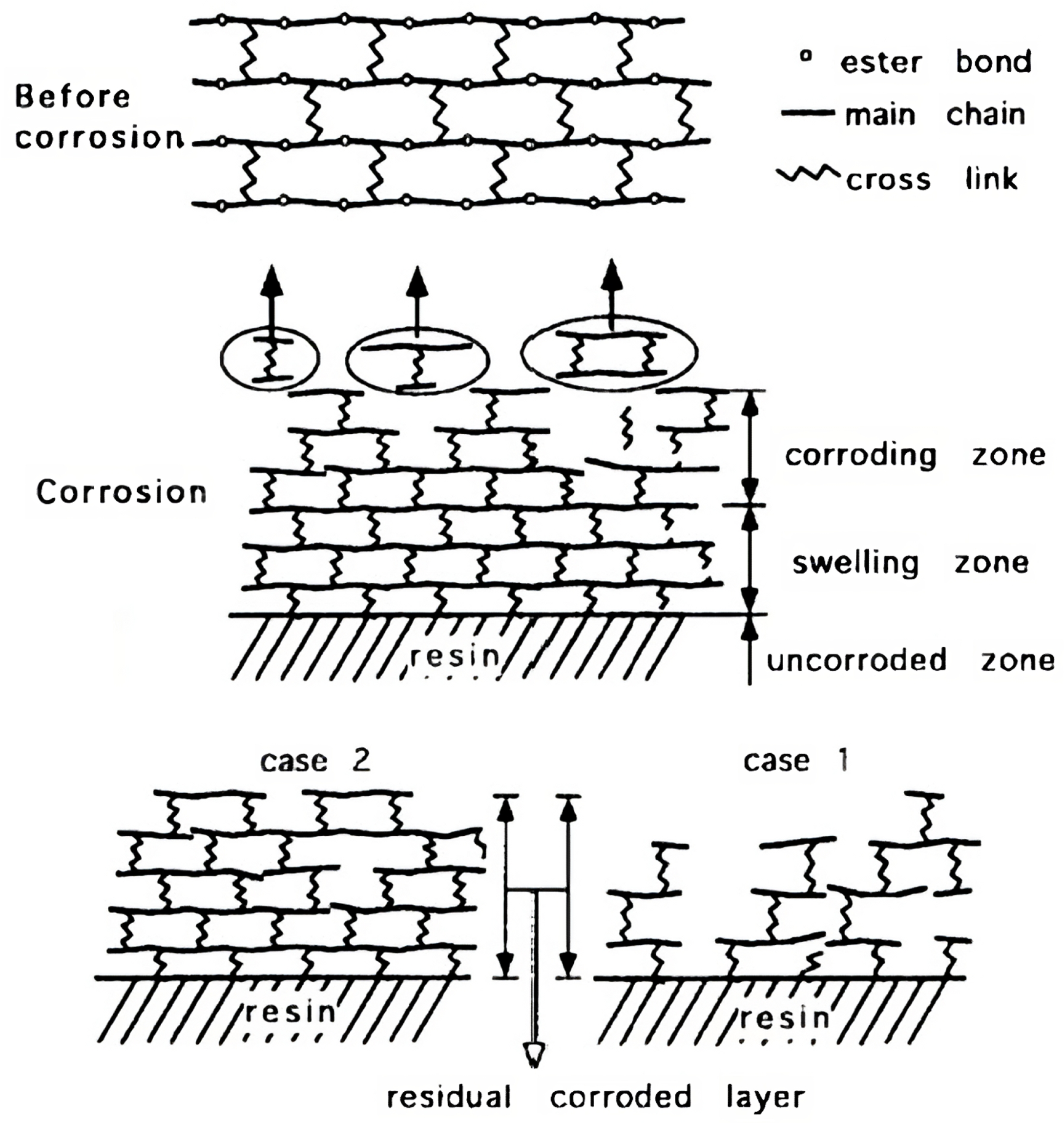
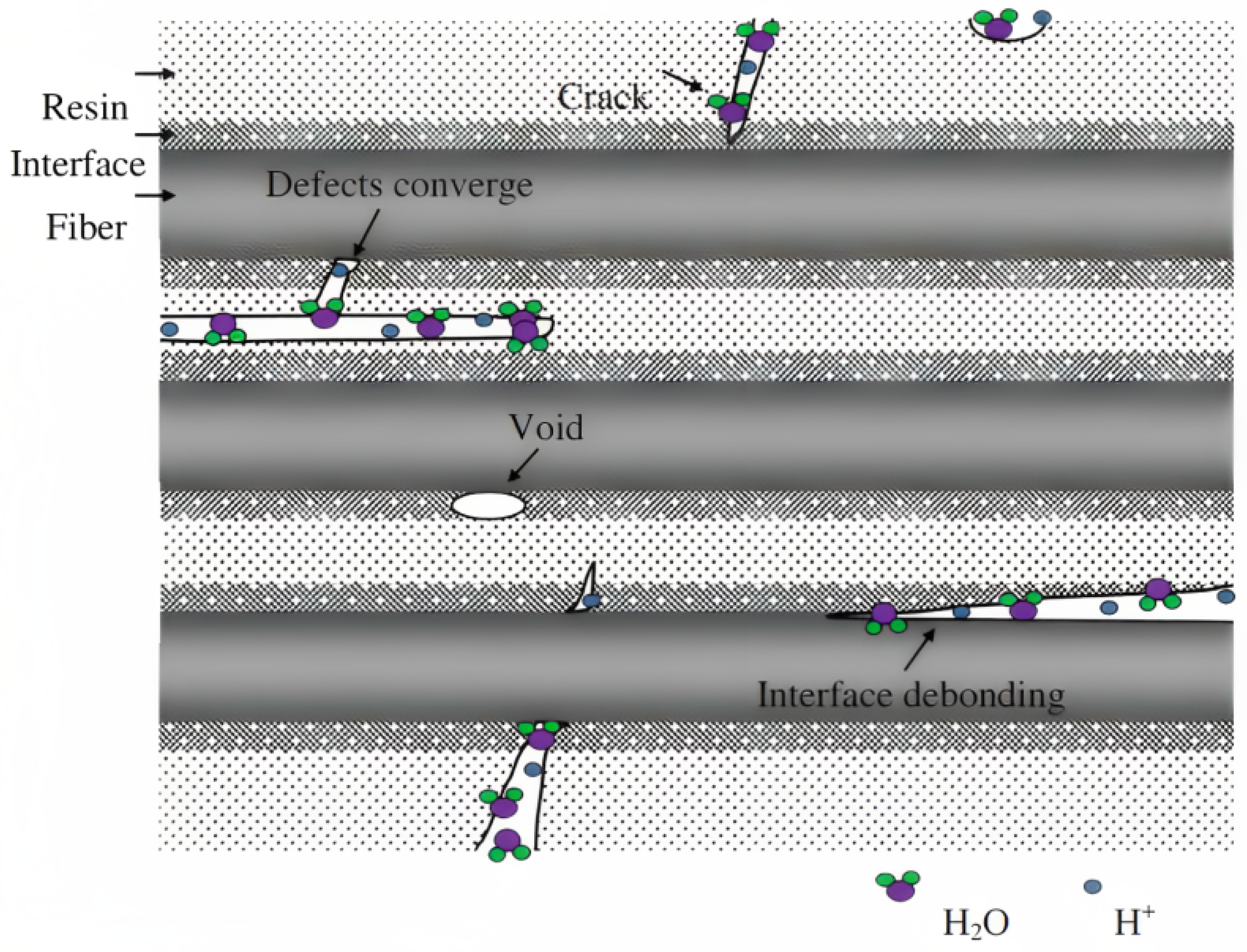
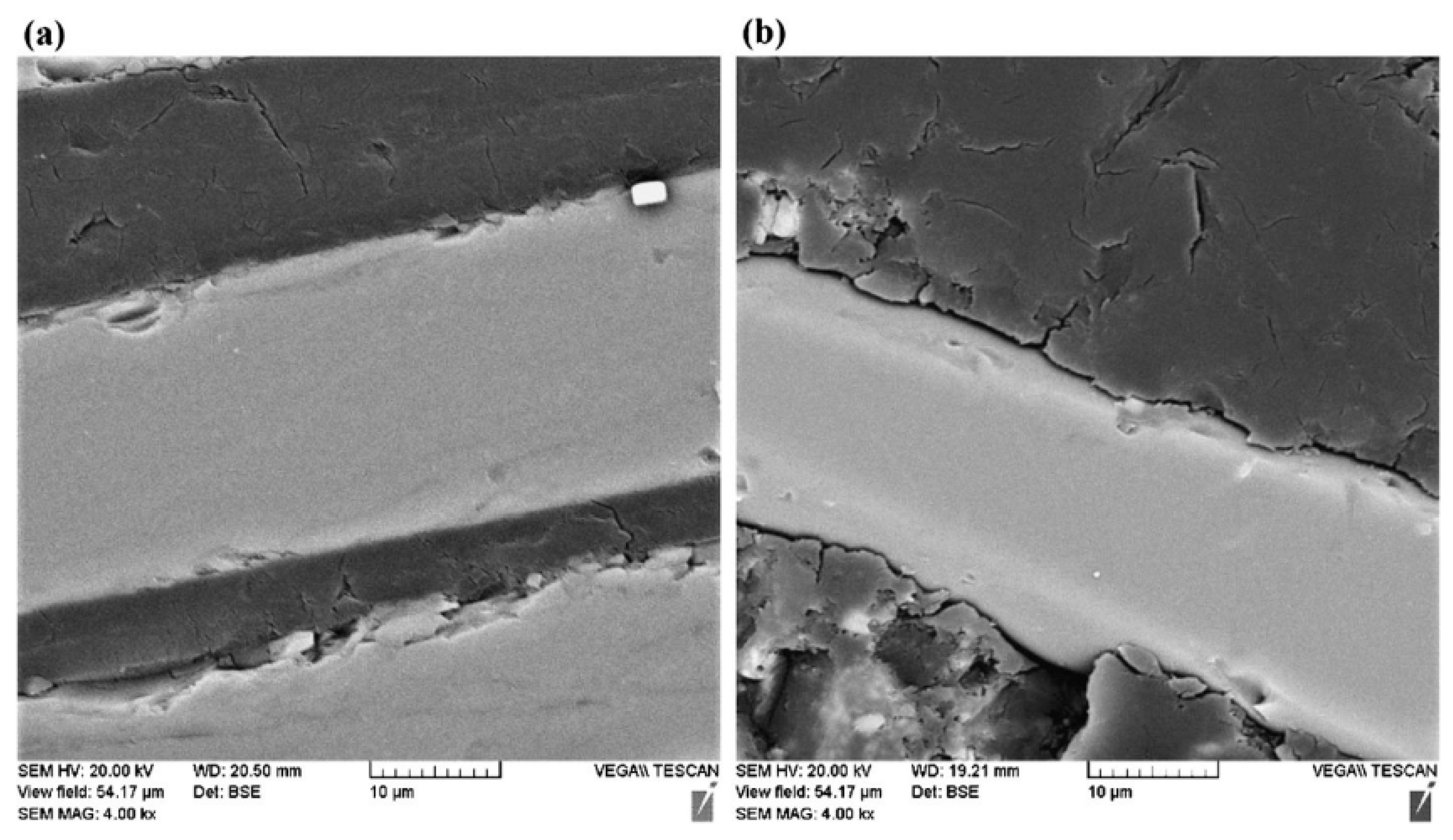
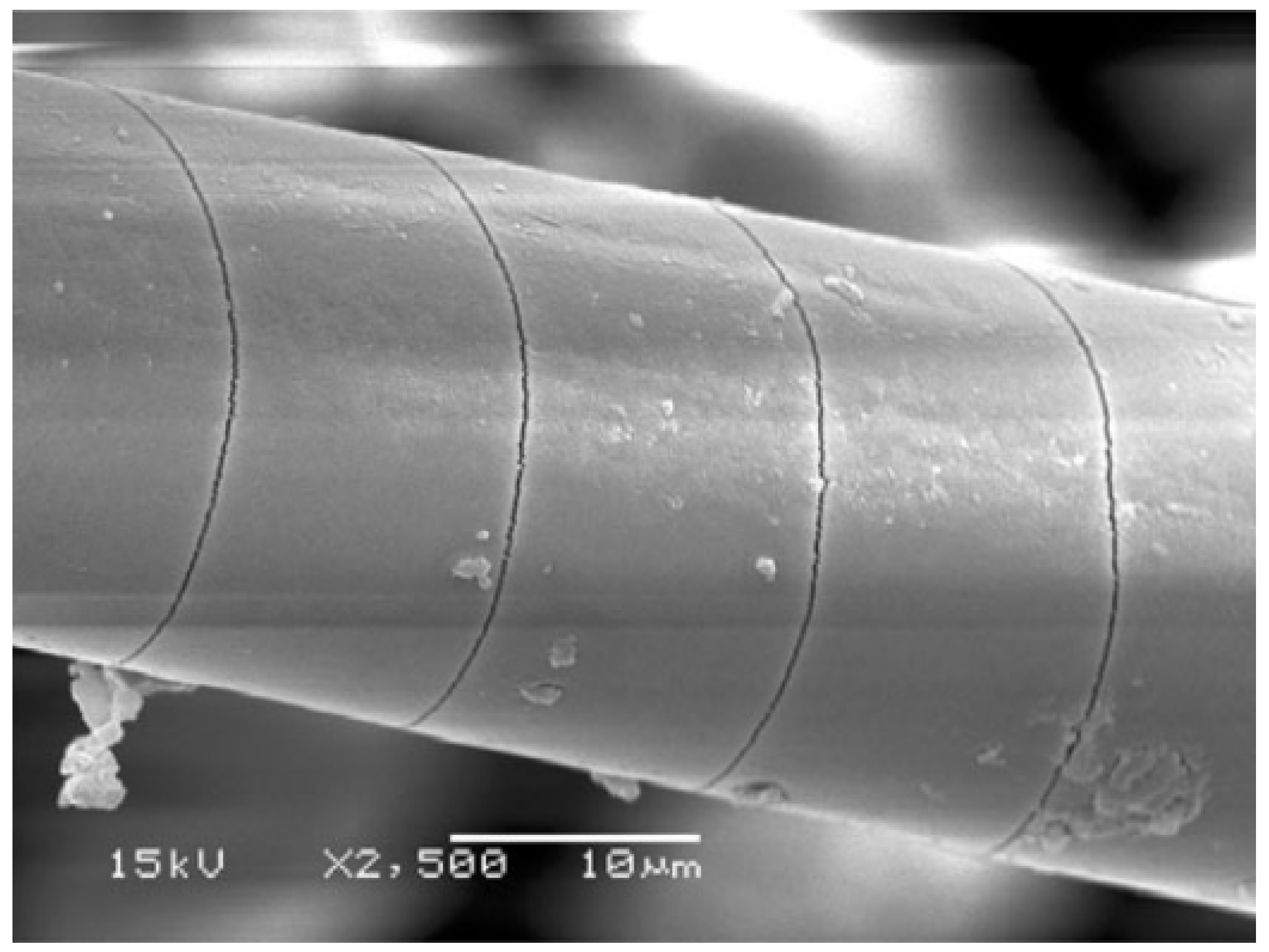

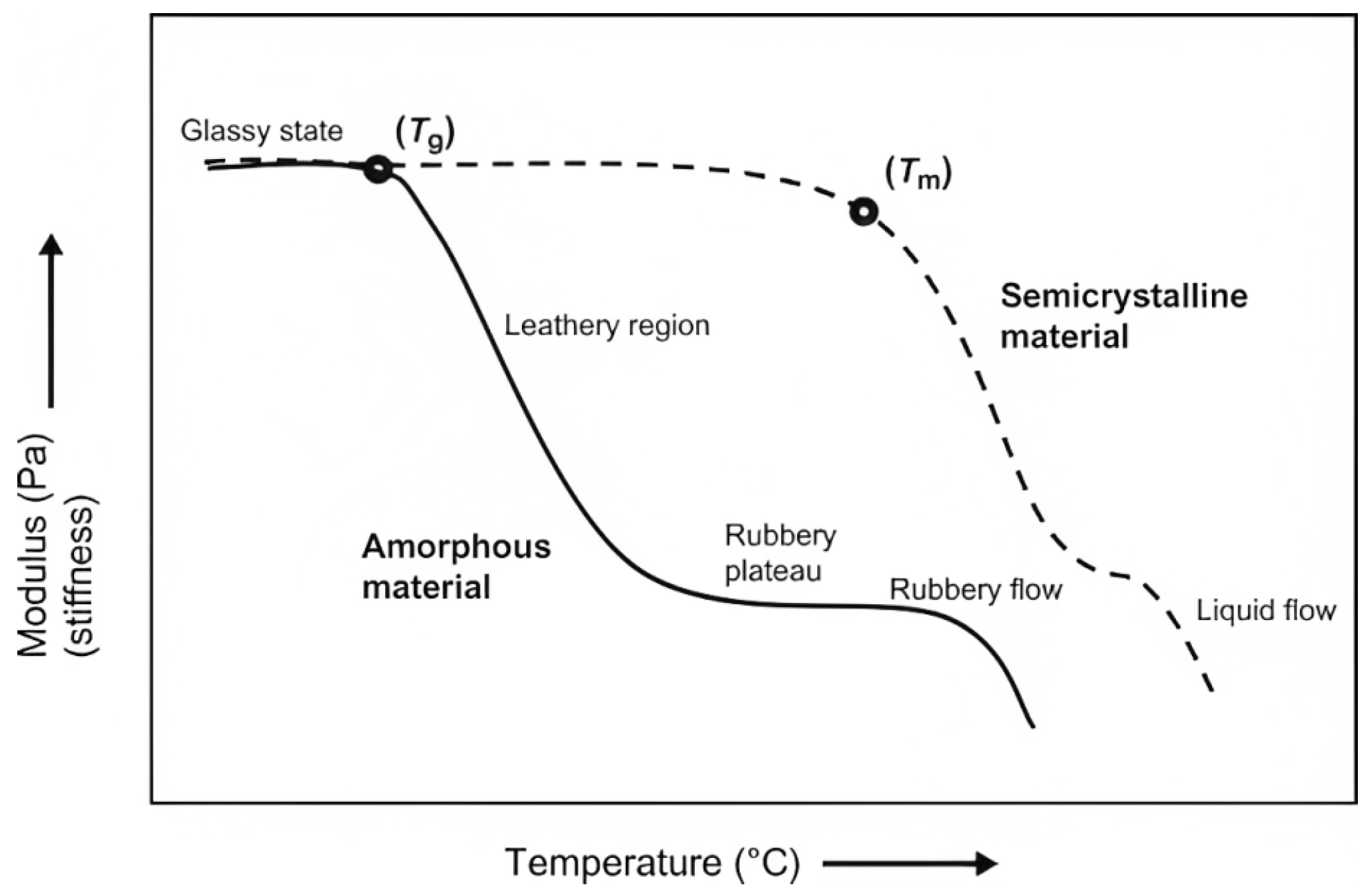

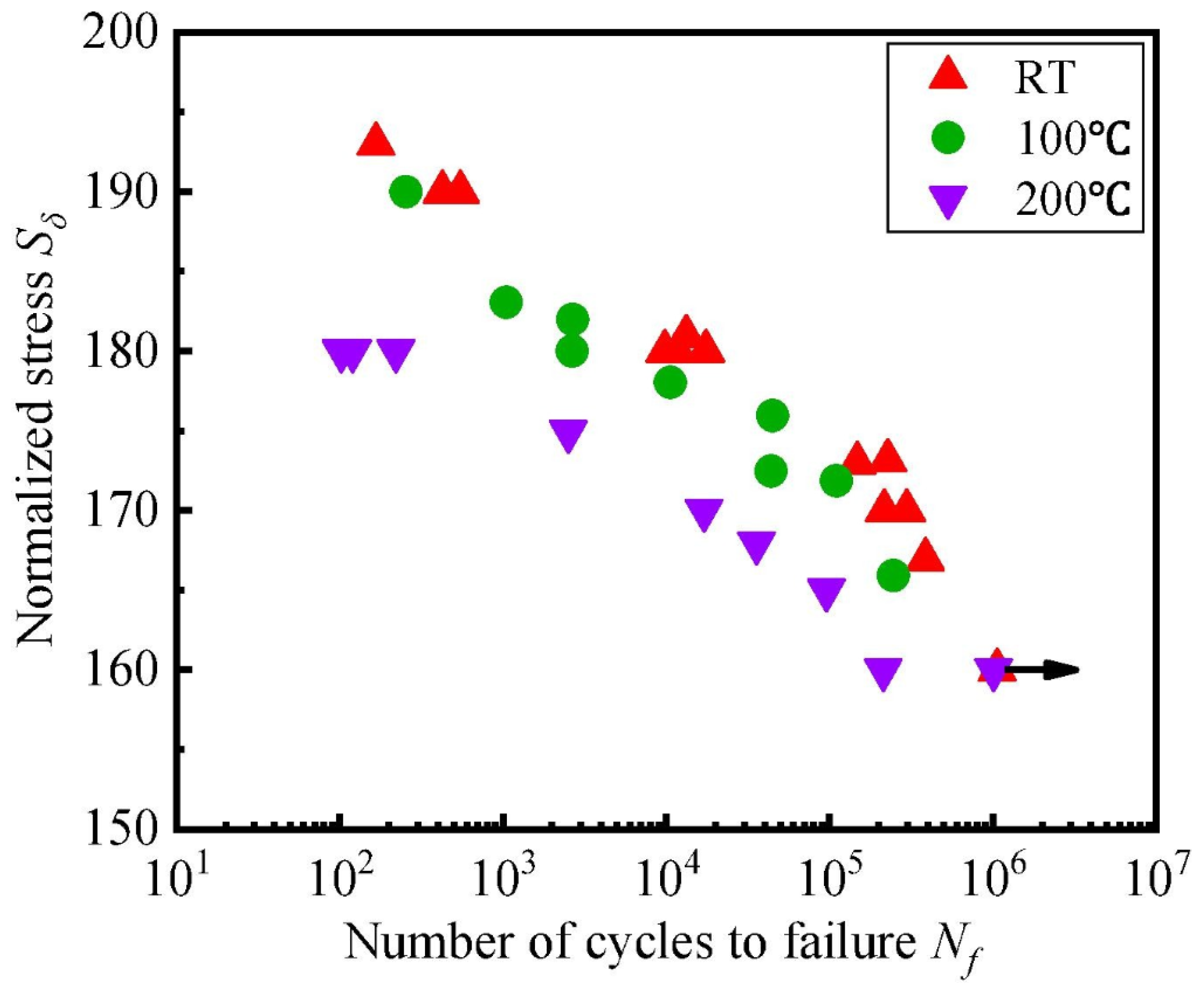

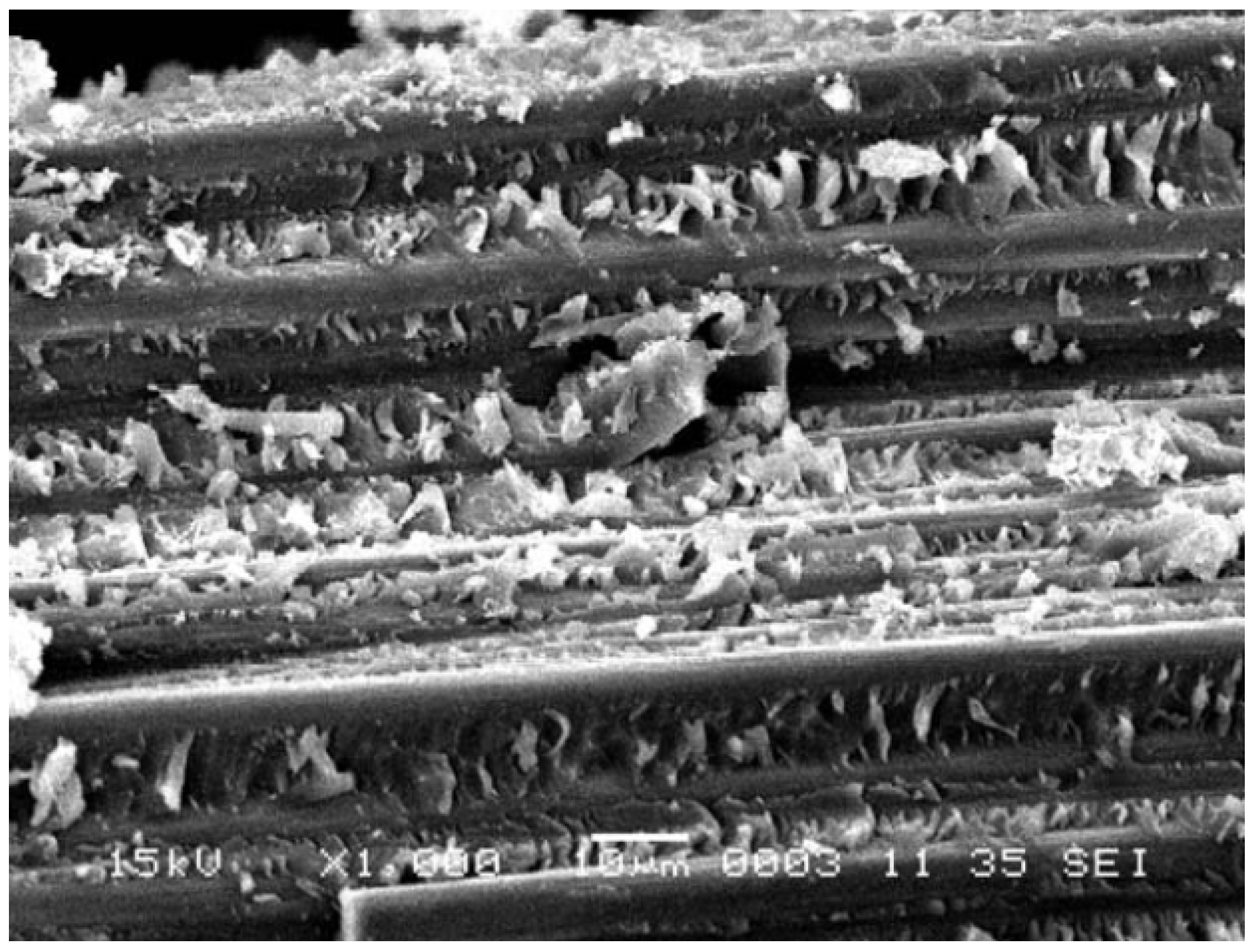
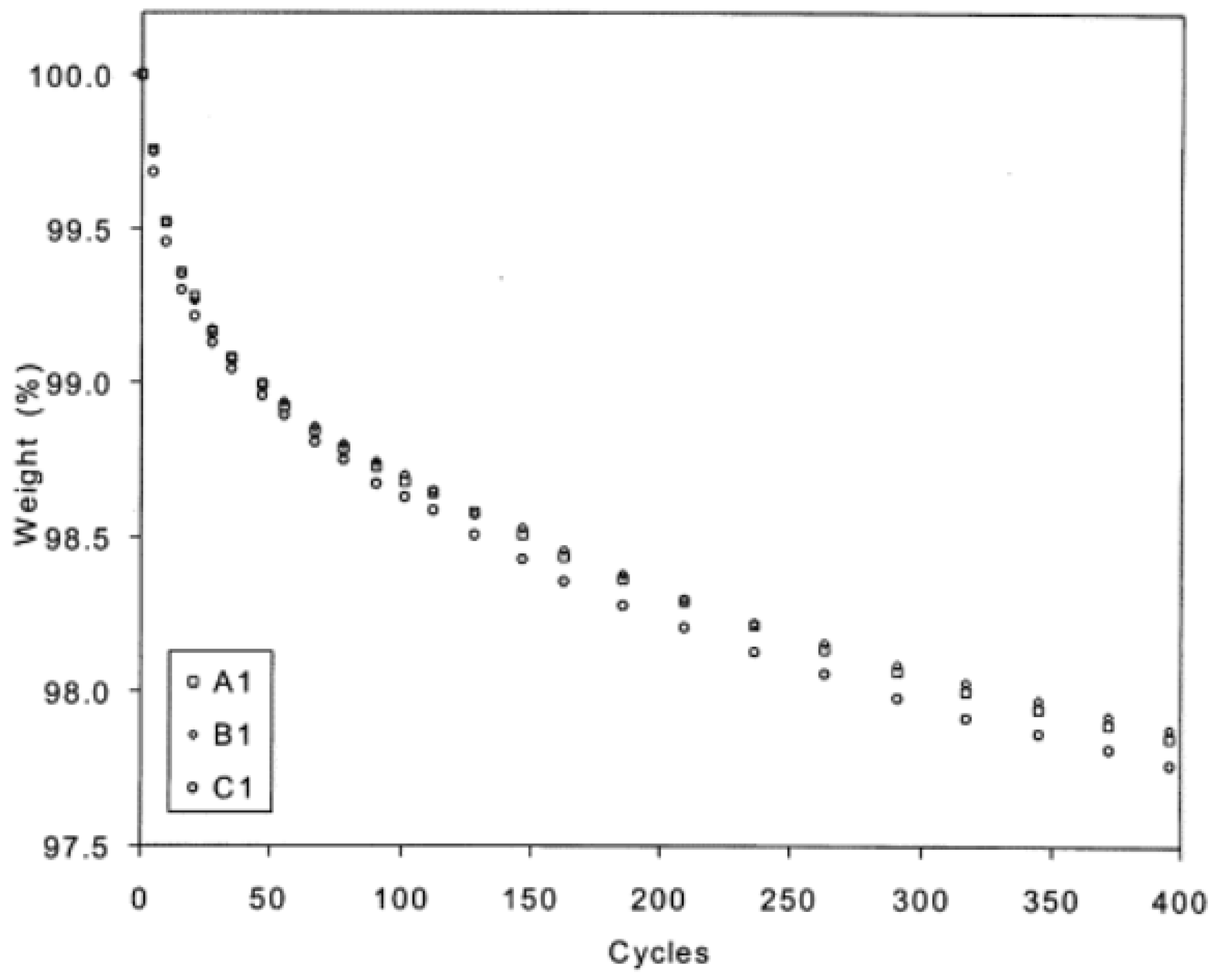

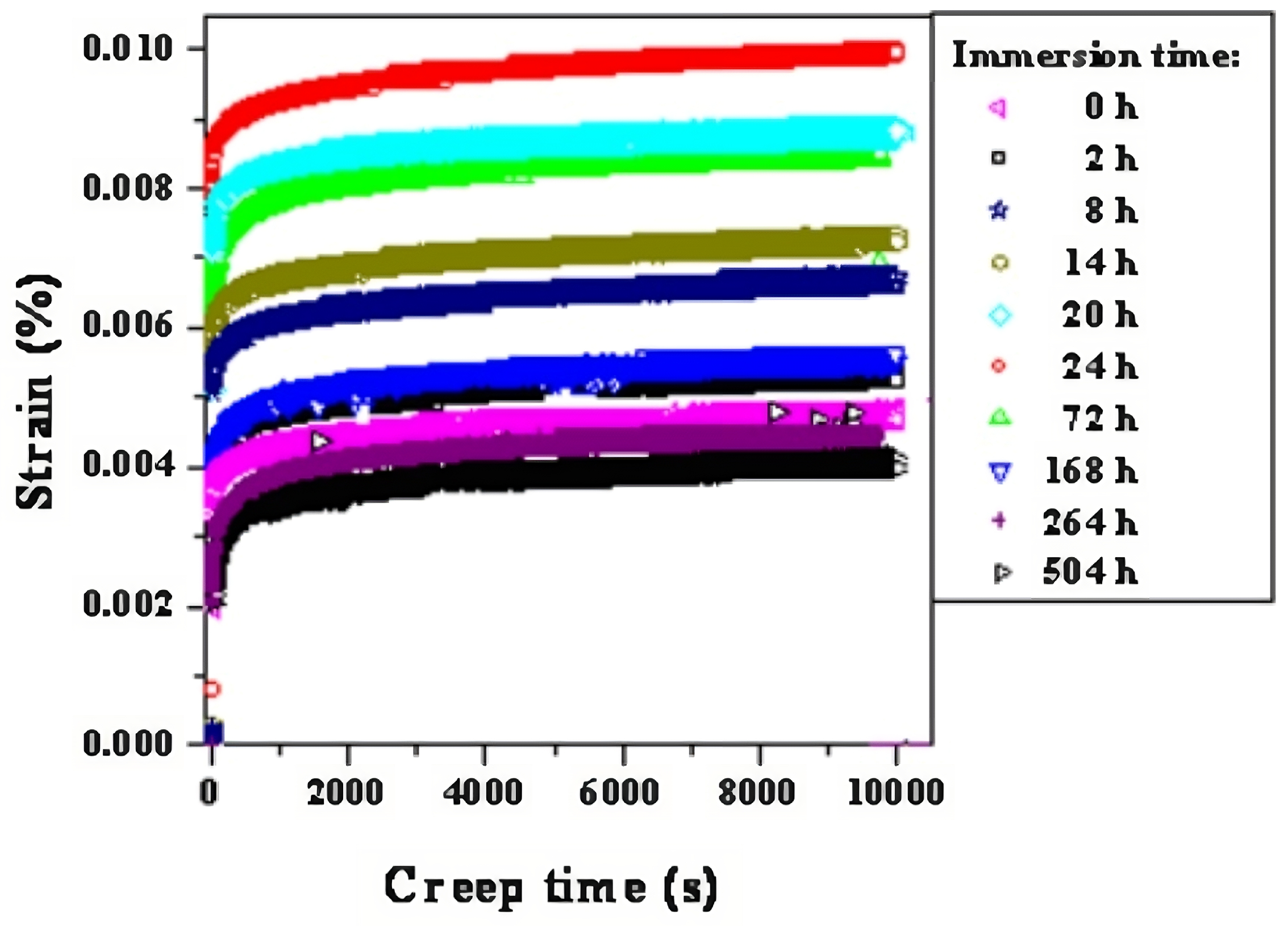
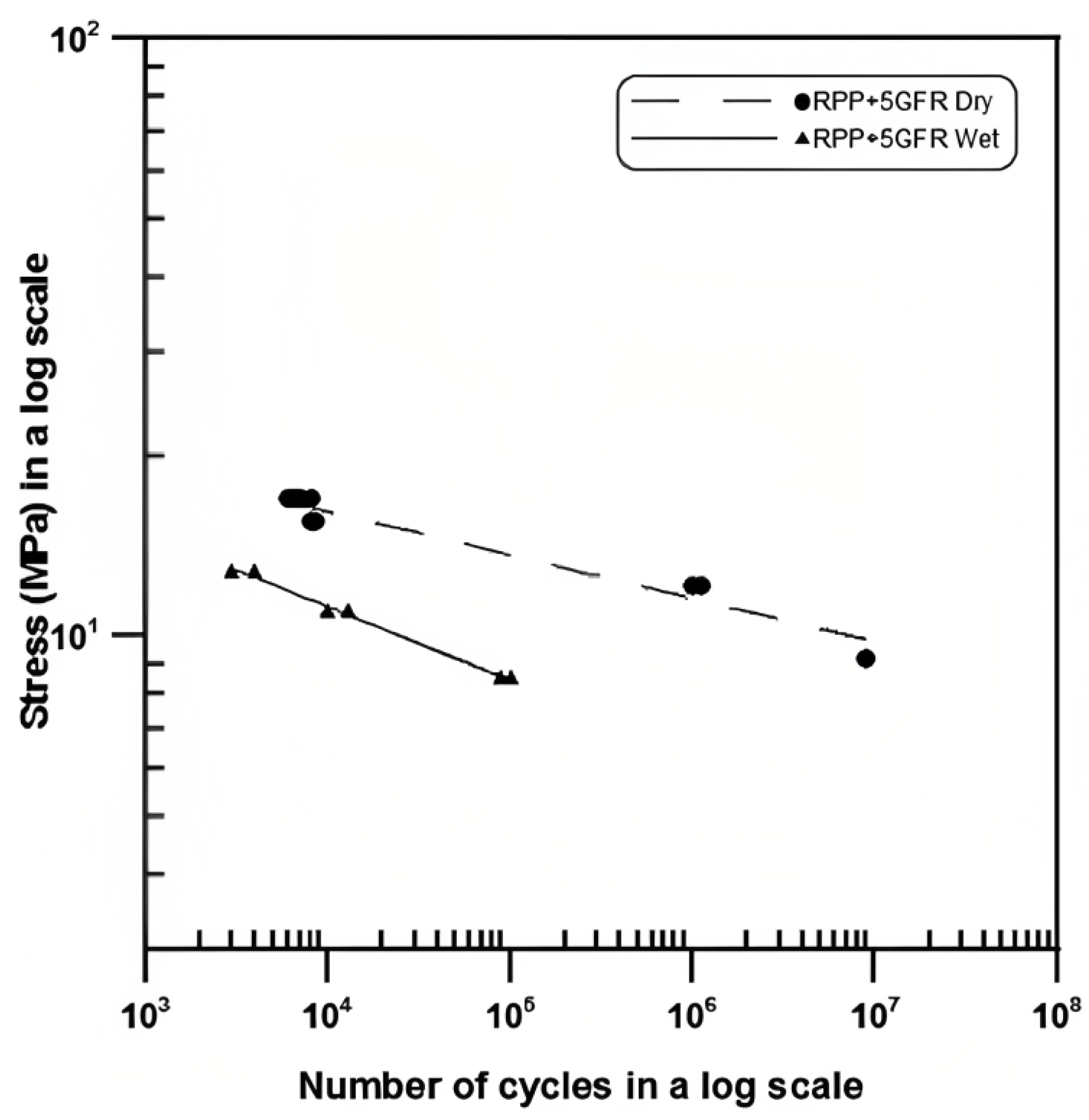
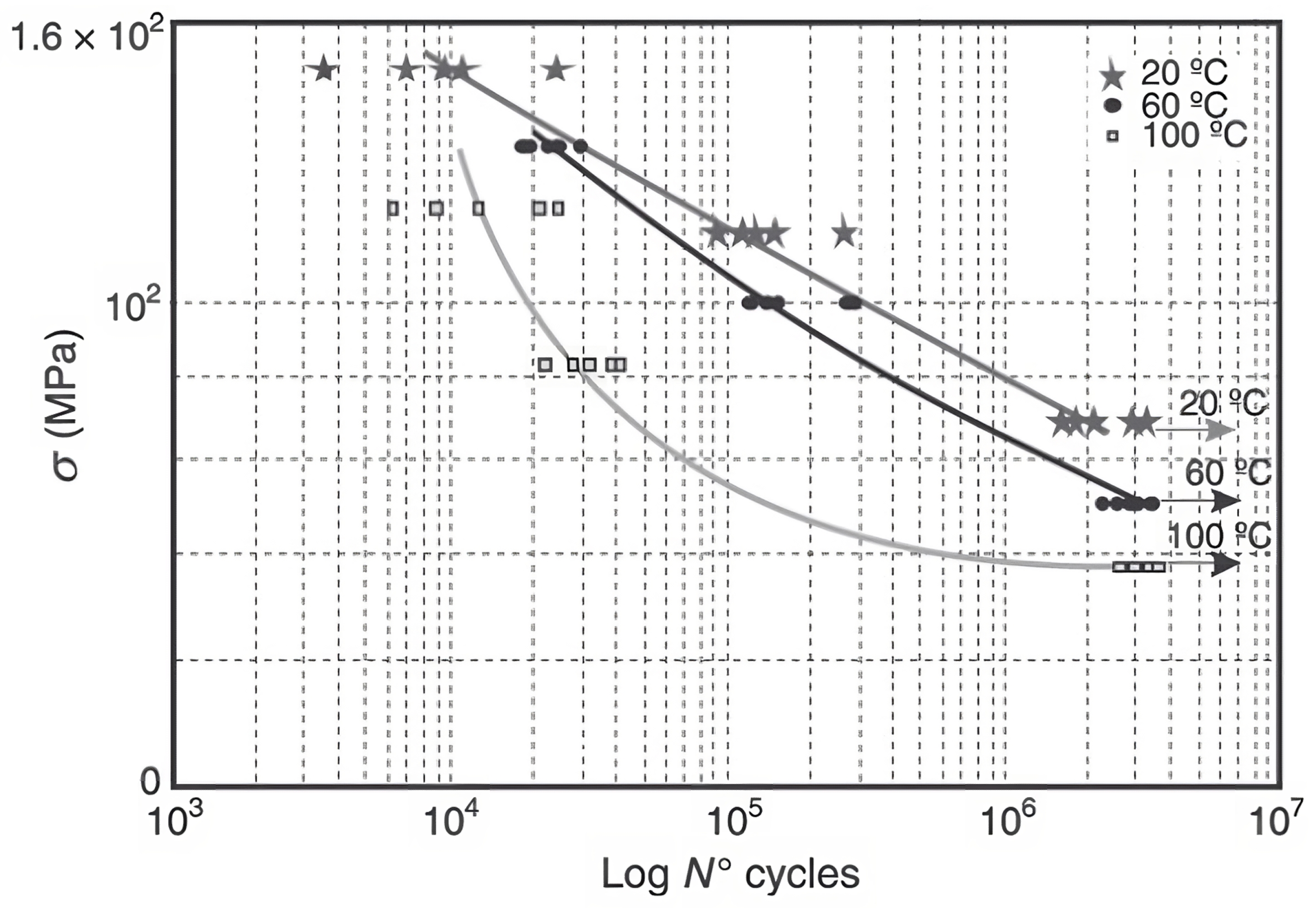
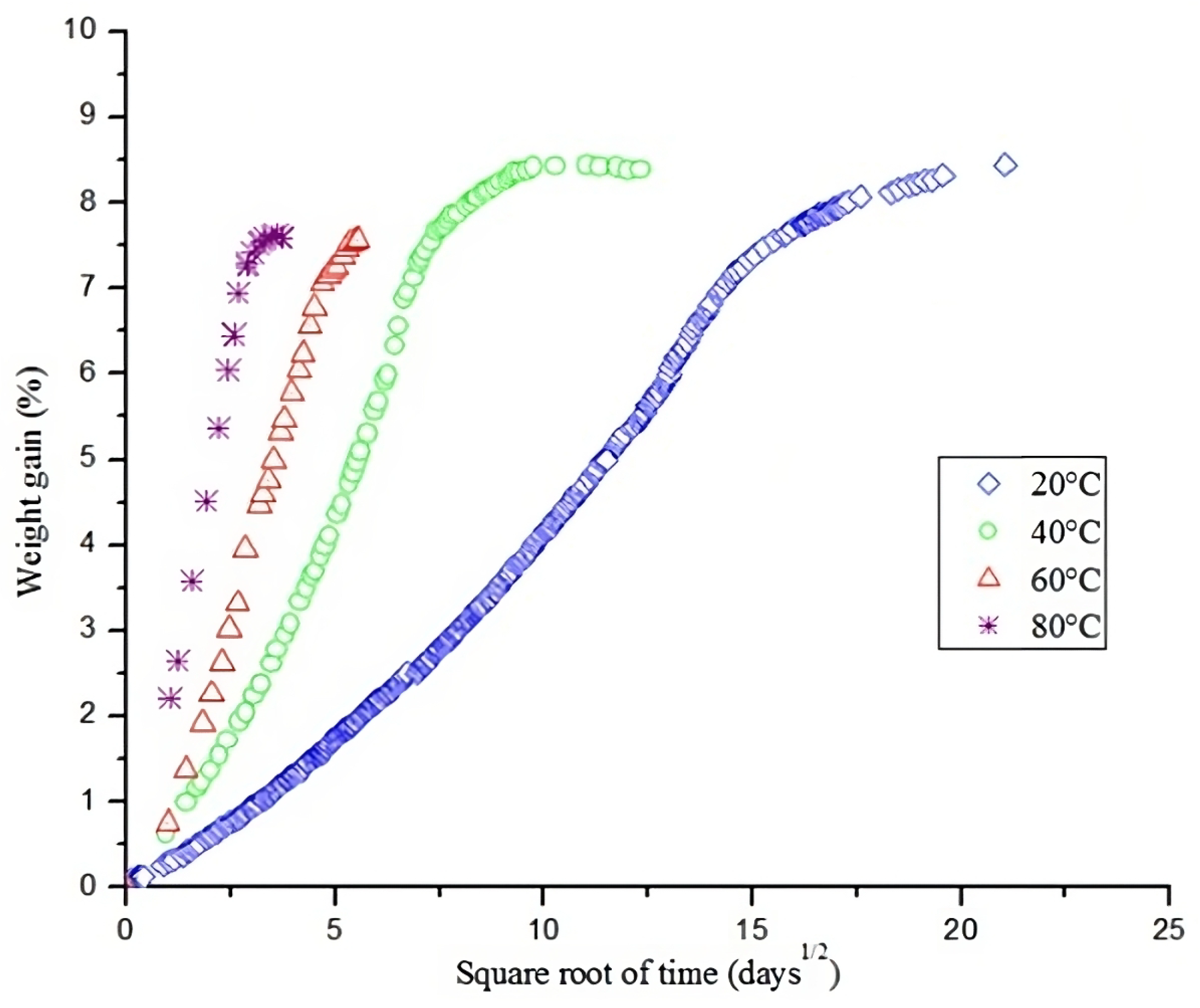



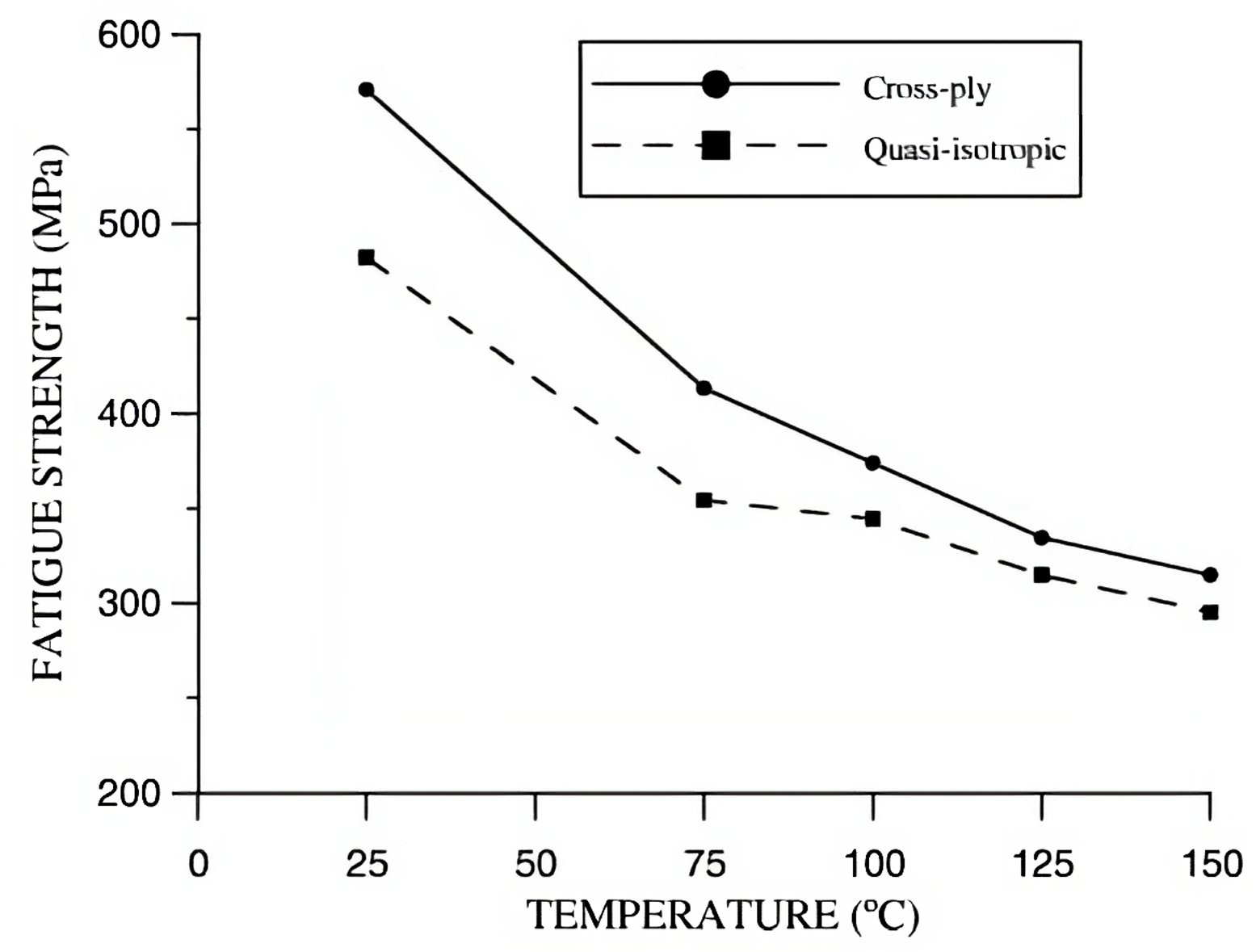
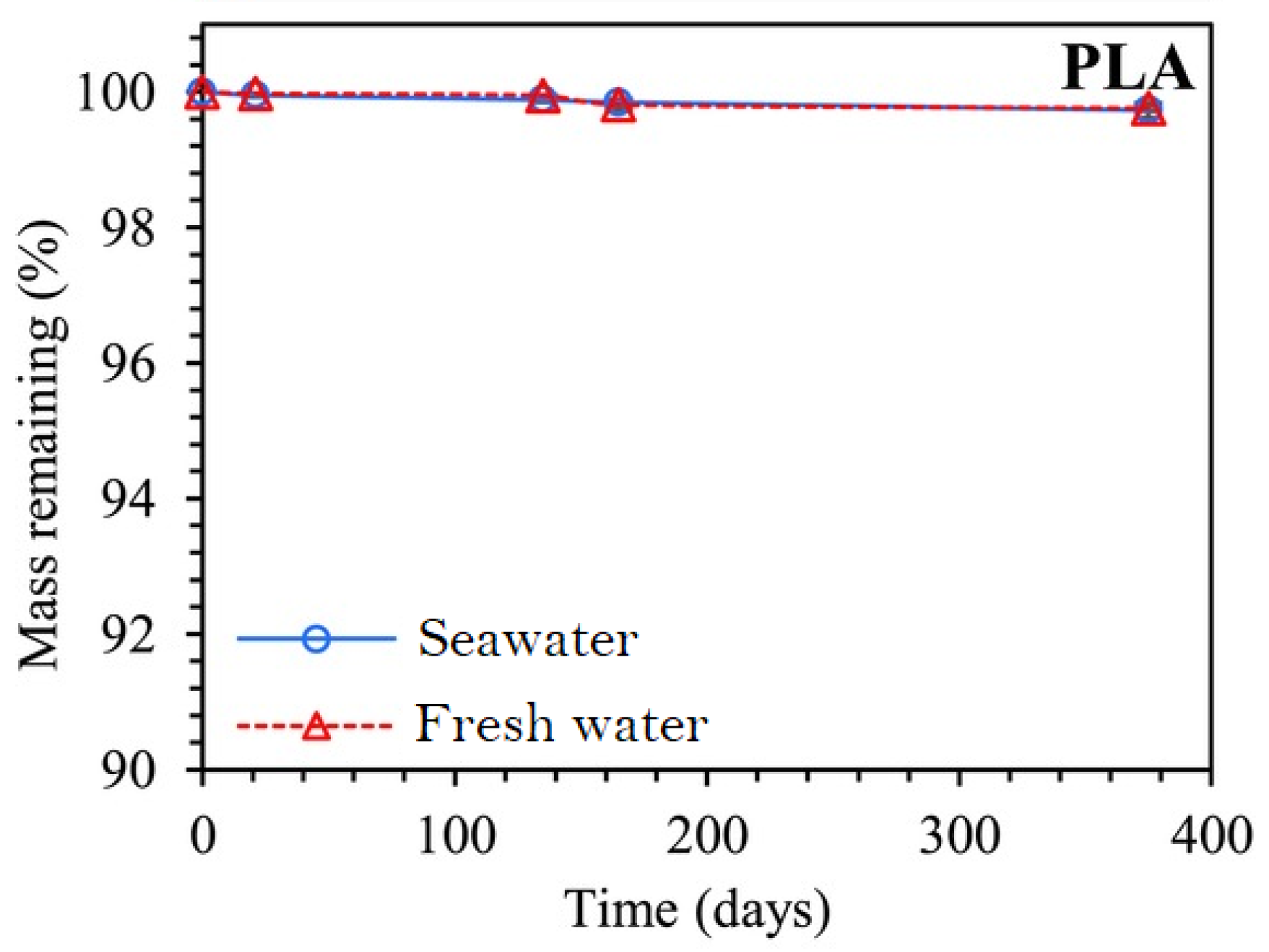
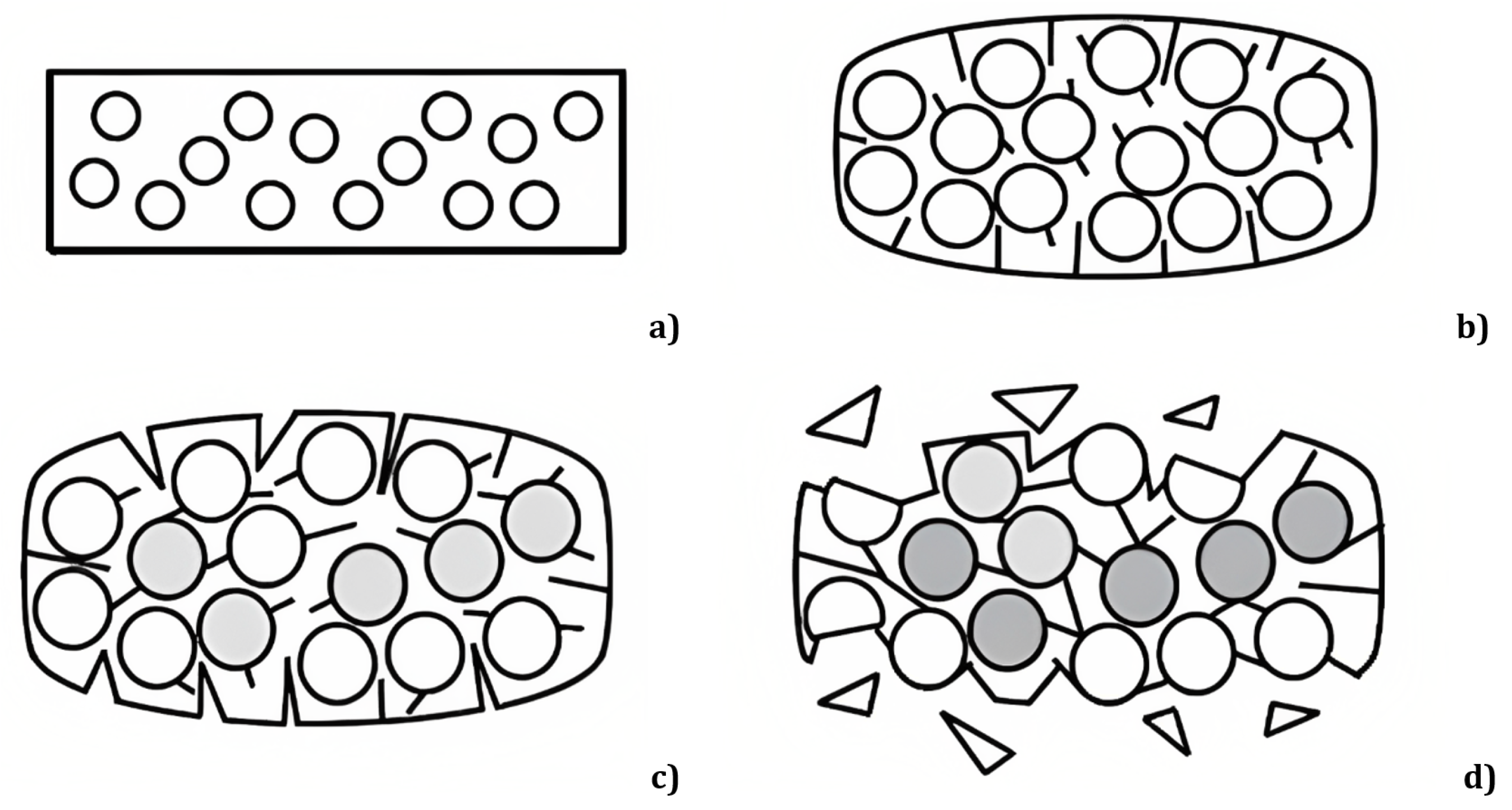
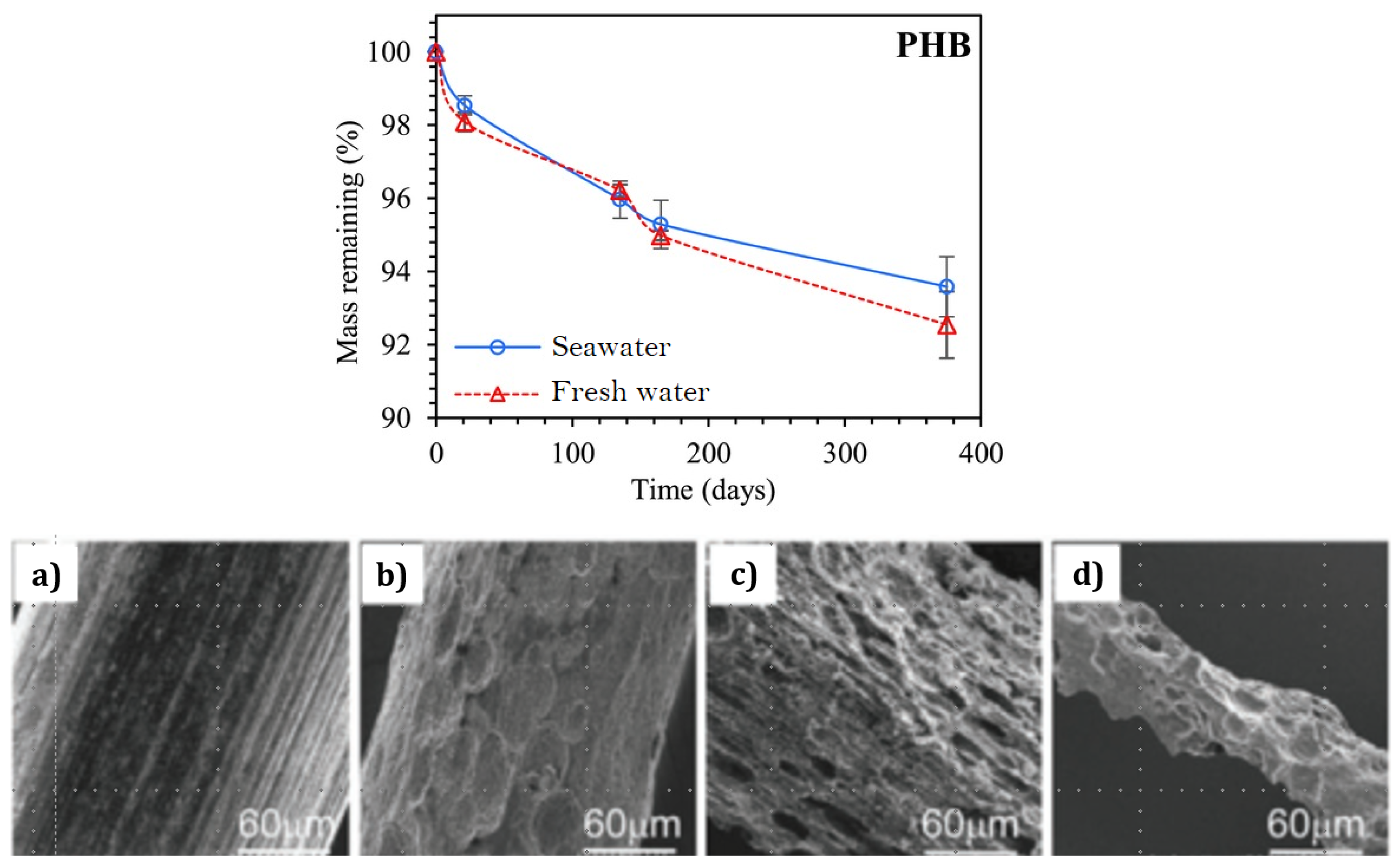
Disclaimer/Publisher’s Note: The statements, opinions and data contained in all publications are solely those of the individual author(s) and contributor(s) and not of MDPI and/or the editor(s). MDPI and/or the editor(s) disclaim responsibility for any injury to people or property resulting from any ideas, methods, instructions or products referred to in the content. |
© 2023 by the authors. Licensee MDPI, Basel, Switzerland. This article is an open access article distributed under the terms and conditions of the Creative Commons Attribution (CC BY) license (https://creativecommons.org/licenses/by/4.0/).
Share and Cite
Barreira-Pinto, R.; Carneiro, R.; Miranda, M.; Guedes, R.M. Polymer-Matrix Composites: Characterising the Impact of Environmental Factors on Their Lifetime. Materials 2023, 16, 3913. https://doi.org/10.3390/ma16113913
Barreira-Pinto R, Carneiro R, Miranda M, Guedes RM. Polymer-Matrix Composites: Characterising the Impact of Environmental Factors on Their Lifetime. Materials. 2023; 16(11):3913. https://doi.org/10.3390/ma16113913
Chicago/Turabian StyleBarreira-Pinto, Rui, Rodrigo Carneiro, Mário Miranda, and Rui Miranda Guedes. 2023. "Polymer-Matrix Composites: Characterising the Impact of Environmental Factors on Their Lifetime" Materials 16, no. 11: 3913. https://doi.org/10.3390/ma16113913






